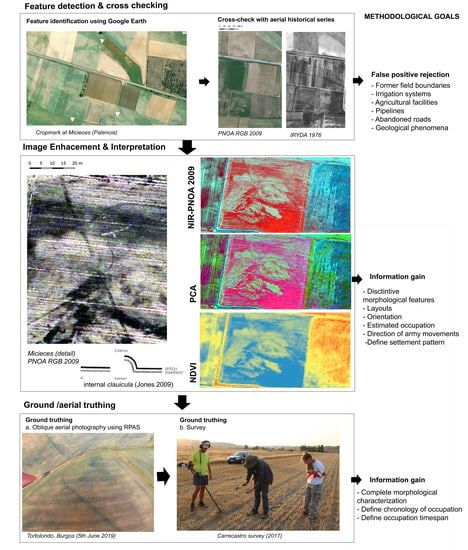Following the Roman Army between the Southern Foothills of the Cantabrian Mountains and the Northern Plains of Castile and León (North of Spain): Archaeological Applications of Remote Sensing and Geospatial Tools
Abstract
1. Introduction
2. Case Study and Research Context
3. Materials and Methods
4. Results
4.1. Northern Castile (Burgos and Palencia Provinces)
4.1.1. Odra-Pisuerga Region (Burgos)
4.1.2. Boedo-Ojeda Region (Palencia)
4.1.3. Montaña Palentina Region (Palencia)
4.1.4. Valdeolea Region (Southern Cantabria)
4.2. Leonese Region
4.2.1. River Bernesga Basin—Surroundings of León
Villaquilambre Cluster
Oteruelo, Trobajo and San Andrés Cluster
Oteruelo-Armunia Fortlet
Sariegos
San Miguel del Camino
4.2.2. River Tuerto Basin—Surroundings of Astorga
La Silva
Sueros
Astorga Cluster
Villamontán Complex
Garaballes
5. Discussion
5.1. Defining Mobility and Settlement Patterns
5.2. The Recurrent Use of Space
5.3. Creating Holistic Narratives on the Roman Military Deployment in Northwestern Iberia and the Indigenous Response
6. Conclusions: More than New Dots on A Map!
Author Contributions
Funding
Acknowledgments
Conflicts of Interest
References
- Bolado del Castillo, R.; Gutiérrez Cuenca, E.; Hierro Gárate, J.Á. Las guerras cántabras. In Cántabros. Origen de un Pueblo; Ocejo Herrero, Á., Bolado del Castillo, R., Gutiérrez Cuenca, E., Hierro Gárate, J.Á., Cabria Gutiérrez, J.C., Eds.; Ediciones Tantín: Santander, Spain, 2012; pp. 95–202. [Google Scholar]
- Costa-García, J.M.; Fonte, J. Scope and limitations of airborne LiDAR technology for the detection and analysis of Roman military sites in Northwest Iberia. In Archaeology and Geomatics. Harvesting the Benefits of 10 Years of Training in the Iberian Peninsula (2006–2015); Mayoral Herrera, V., Parcero-Oubiña, C., Fábrega-Álvarez, P., Eds.; Sidestone Press: Leiden, The Netherlands, 2017; pp. 57–73. [Google Scholar]
- Cordero Ruiz, T.; Cerrillo Cuenca, E.; Pereira, C. Detección de un nuevo campamento romano en las inmediaciones de Mérida mediante tecnología LiDAR. Saguntum 2017, 49, 197–201. [Google Scholar] [CrossRef]
- Berrocal-Rangel, L.; Paniego Díaz, P.; Ruano, L.; Manglano Valcárcel, G.R. Aplicaciones LiDAR a la topografía arqueológica: El Castro de Irueña (Fuenteguinaldo, Salamanca). Cuad. Prehist. Arqueol. 2017, 43, 195–215. [Google Scholar] [CrossRef]
- Fernández-Lozano, J.; Gutiérrez-Alonso, G.; Fernández-Morán, M.Á. Using airborne LiDAR sensing technology and aerial orthoimages to unravel roman water supply systems and gold works in NW Spain (Eria valley, León). J. Archaeol. Sci. 2015, 53, 356–373. [Google Scholar] [CrossRef]
- Costa-García, J.M.; Fonte, J.; Gago, M. The reassessment of the Roman military presence in Galicia and Northern Portugal through digital tools: Archaeological diversity and historical problems. Mediterr. Archaeol. Archaeom. 2019, 19, 17–49. [Google Scholar] [CrossRef]
- Peralta Labrador, E.J.; Camino Mayor, J.; Torres-Martínez, J.F. Recent research on the Cantabrian Wars: The archaeological reconstruction of a mountain war. J. Roman Archaeol. 2019, 32, 421–438. [Google Scholar] [CrossRef]
- González Ruibal, A. The politics of identity: Ethnicity and the economy of power in Iron Age northern Iberia. In Landscape, Ethnicity and Identity in the Archaic Mediterranean Area; Cifani, G., Stoddart, S., Eds.; Oxbow Books: Oxford, UK, 2012; pp. 245–266. [Google Scholar]
- Currás, B.X.; Sastre, I.; Orejas, A. Del castro a la civitas: Dominación y resistencia en el Noroeste hispano. In Celebração do Bimilenário de Augusto. Ad Nationes. Ethnous Kallaikon; Morais, R., Navarro Caballero, M., Eds.; Câmara Municipal de Braga: Braga, Portugal, 2016; pp. 125–135. [Google Scholar]
- Costa-García, J.M. Rediscovering the Roman Conquest of the North-western Iberian Peninsula. In Conflict Archaeology. Materialities of Collective Violence from Prehistory to Late Antiquity; Fernández-Götz, M., Roymans, N., Eds.; Routledge: Oxford, UK, 2017; pp. 141–151. [Google Scholar]
- Sastre Prats, I. Las Formaciones Sociales de la Asturia Romana; Ediciones Clásicas: Madrid, Spain, 2001. [Google Scholar]
- Marín Suárez, C.; González-Álvarez, D. La romanización del occidente cantábrico: De la violencia física a la violencia simbólica. Férvedes Revis. Investig. 2011, 7, 197–206. [Google Scholar]
- Fernández Ochoa, C.; Morillo Cerdán, Á. Astures y romanos. Claves para una interpretación historiográfica de la romanización en Asturias. In Astures y Romanos: Nuevas Perspectivas; Fernández-Tresguerres, J., Ed.; Real Instituto de Estudios Asturianos: Oviedo, Spain, 2007; pp. 11–26. [Google Scholar]
- Sastre, I.; Currás, B.X. Aggregation and Dispersal: Rural Landscapes of the Northwestern Iberian Peninsula from the Iron Age to the Early Roman Empire. In Coming Together: Comparative Approaches to Population Aggregation and Early Urbanization; Gyucha, A., Ed.; SUNY Press: Albany, NY, USA, 2019; pp. 295–320. [Google Scholar]
- Fernández Ochoa, C.; Morillo Cerdán, Á. La romanización atlántica: Modelo o modelos de implantación romana en el noroeste peninsular. Portugalia 2015, 36, 183–197. [Google Scholar]
- Morillo Cerdán, Á.; Martín Hernández, E. El ejército romano en la Península Ibérica: De la ‘Arqueología Filológica’ a la Arqueología Militar Romana. Estud. Humaníst. Hist. 2005, 4, 177–208. [Google Scholar] [CrossRef][Green Version]
- Camino Mayor, J.; Peralta Labrador, E.; Torres Martínez, J.F. (Eds.) Las Guerras Astur-Cántabras; KRK Ediciones: Gijón, Spain, 2015. [Google Scholar]
- Menéndez Blanco, A.; González-Álvarez, D.; Costa García, J.M.; Fonte, J.; Gago Mariño, M.; Álvarez Martínez, V. Seguindo os passos do exército romano: Uma proposta metodológica para a deteção de assentamentos militares romanos no Noroeste Peninsular. In Genius Loci: Lugares e Significados | Places and Meanings; Rosas, L., Sousa, A.C., Barreira, H., Eds.; CITCEM—Centro de Investigação Transdisciplinar «Cultura, Espaço e Memória»: Porto, Portugal, 2017; Volume 2, pp. 67–79. [Google Scholar]
- Didierjean, F.; Morillo Cerdán, Á.; Petit-Aupert, C. Traces des guerres, traces de paix armée: L’apport de quatre campagnes de prospection aérienne dans le nord de l’Espagne. In La Guerre et ses Traces. Conflits et Sociétés en Hispanie à L’époque de la Conquête Romaine (IIIe-Ier s. a.C.); Cadiou, F., Caballero, M.N., Eds.; Ausonius: Bordeaux, France, 2014; pp. 149–179. [Google Scholar]
- Costa-García, J.M.; Menéndez Blanco, A.; González-Álvarez, D.; Gago Mariño, M.; Fonte, J.; Blanco-Rotea, R.; Álvarez Martínez, V. The Presence of the Roman Army in North-Western Hispania: New Archaeological Data from Ancient Asturias and Galicia. In Proceedings of the 23rd International Limes Congress in Ingolstadt 2015, Ingolstadt, Germany, 12–23 September 2015; Sommer, C.S., Matešić, S., Eds.; Nünnerich-Asmus: Mainz, Germany, 2018; Volume 2, pp. 903–910. [Google Scholar]
- Martín Hernández, E. El Mouro. Castrametación en la vía de la Mesa (Belmonte de Miranda/Grao, Asturias). In Las Guerras-Ástur-Cántabras; Camino Mayor, J., Peralta Labrador, E., Torres Martínez, J.F., Eds.; KRK Ediciones: Gijón, Spain, 2015; pp. 239–247. [Google Scholar]
- Martín Hernández, E.; Camino Mayor, J.; El Picu, L. lagüezos, un nuevo campamento romano en la vía Carisa. In Excavaciones Arqueológicas en Asturias 2007–2012. En el Centenario del Descubrimiento de la Caverna de La Peña de Candamo; Consejería de Educación, Cultura y Deporte del Principado de Asturias: Oviedo, Spain, 2013; pp. 267–276. [Google Scholar]
- Costa-García, J.M.; Fonte, J.; Gago Mariño, M.; Menéndez Blanco, A.; Álvarez Martínez, V. Hallazgos arqueológicos recientes para el estudio de la presencia militar romana en el oriente gallego. Gallaecia 2017, 35, 39–70. [Google Scholar] [CrossRef]
- Hierro Gárate, J.Á.; Vidal Encinas, J.M.; Peralta Labrador, E.; Gutiérrez Cuenca, E.; Bolado del Castillo, R. Primeras evidencias arqueológicas del asedio romano al castro de Las Labradas-El Marrón (Arrabalde, Zamora) durante el Bellum Astvricum. Estud. Humanist. Hist. 2018, 17, 1–27. [Google Scholar]
- Vidal Encinas, J.M.; Costa-García, J.M.; González-Álvarez, D.; Menéndez Blanco, A. La presencia del ejército romano en las montañas de El Bierzo (León): Novedades arqueológicas. An. Arqueol. Cordob. 2018, 29, 85–110. [Google Scholar] [CrossRef]
- Orejas, A.; Sánchez-Palencia, F.J.; Beltrán, A.; Ron, J.A.; López, L.F.; Currás, B.X.; Romero, D.; Zubiaurre, E.; Pecharromán, J.L.; Arboledas, L. Conquista, articulación del territorio y explotación de recursos en el límite entre el convento lucense y el de los ástures (Proyecto IVGA). In Las Guerras Astur-Cántabras; Camino Mayor, J., Peralta Labrador, E., Torres Martínez, J.F., Eds.; KRK Ediciones: Gijón, Spain, 2015; pp. 247–260. [Google Scholar]
- Costa-García, J.M.; Menéndez Blanco, A.; Fonte, J.; Alonso Toucido, F. A Penaparda (A Fonsagrada, Lugo–Santalla, Asturias): Intervención arqueológica en un recinto campamental romano en el Occidente de la Cordillera Cantábrica. CEH 2020, 67, 45–74. [Google Scholar] [CrossRef]
- Blanco Vázquez, L.; Suárez Manjón, P. Campamento romano de Moyapán (Allande). Actuación arqueológica. In Excavaciones Arqueológicas en Asturias 2007–2012. En el Centenario del Descubrimiento de la Caverna de La Peña de Candamo; León Gasalla, P., Ed.; Consejería de Educación, Cultura y Deporte: Oviedo, Spain, 2014; pp. 419–422. [Google Scholar]
- Martín Hernández, E.; Camino Mayor, J. Investigaciones arqueológicas en el cordal de La Carisa. Los campamentos de L. Lagüezos y La Cuaña Carraceo. In Excavaciones Arqueológicas en Asturias 2013–2016; León Gasalla, P., Ed.; Consejería de Educación y Cultura, Principado de Asturias–Ediciones Trabe: Oviedo, Spain, 2018; pp. 293–306. [Google Scholar]
- Camino Mayor, J. La línea de operaciones de la vía Carisa (Asturias y norte de León). In Las Guerras Astur-Cántabras; Camino Mayor, J., Peralta Labrador, E., Torres-Martínez, J.F., Eds.; KRK Ediciones: Gijón, Spain, 2015; pp. 217–237. [Google Scholar]
- Menéndez Granda, A.; Sánchez Hidalgo, E. Campaña de sondeos arqueológicos en el campamento de época romana del Pico El Outeiro Zarrado (Taramundi-Villanueva de Oscos). In Excavaciones Arqueológicas en Asturias 2013–2016; León Gasalla, P., Ed.; Consejería de Educación y Cultura, Principado de Asturias-Ediciones Trabe: Oviedo, Spain, 2018; pp. 283–292. [Google Scholar]
- Morillo Cerdán, Á. El territorio galaico durante las guerras cántabras: Nuevas perspectivas. In Celebração do Bimilenário de Augusto. Ad Nationes. Ethnous Kallaikon; Morais, R., Navarro Caballero, M., Eds.; Câmara Municipal de Braga: Braga, Portugal, 2016; pp. 54–72. [Google Scholar]
- Santos Yanguas, N. La conquista de Asturias por Roma: Una nueva perspectiva. Gerión 2017, 37, 151–162. [Google Scholar] [CrossRef][Green Version]
- Orejas, A.; Sánchez-Palencia, F.J. Arqueología de la conquista del noroeste de la Península Ibérica. In II Congreso de Arqueología Peninsular: Zamora, del 24 al 27 de septiembre de 1996. Tomo IV: Arqueología Romana y Medieval; De Balbín Behrmann, R., Bueno Ramírez, P., Eds.; Universidad de Alcalá-Fundación Rei Afonso Henriques: Madrid, Spain, 1999; Volume Tomo IV, pp. 23–37. [Google Scholar]
- Menéndez Blanco, A.; Álvarez Martínez, V.; González-Álvarez, D.; Jiménez Chaparro, J.I. La Sierra de Penouta y el cordal d’Ouroso: Una línea de avance del ejército romano en el occidente cantábrico. In Las Guerras-Ástur-Cántabras; Camino Mayor, J., Peralta Labrador, E., Torres Martínez, J.F., Eds.; KRK Ediciones: Gijón, Spain, 2015; pp. 261–268. [Google Scholar]
- Menéndez Blanco, A.; Costa-García, J.M.; González-Álvarez, D.; Álvarez Martínez, V.; Fonte, J. Los campamentos romanos de Cueiru y El Xuegu la Bola na vía de La Mesa. Resultaos de la campaña del 2016. In Excavaciones Arqueológicas en Asturias 2013–2016; León Gasalla, P., Ed.; Consejería de Educación y Cultura, Principado de Asturias-Ediciones Trabe: Oviedo, Spain, 2018; pp. 273–282. [Google Scholar]
- Peralta Labrador, E. Arqueología de las Guerras Cántabras. Un campo de batalla en las sierras de Iguña y Toranzo. Revis. Arqueol. 1997, 198, 14–23. [Google Scholar]
- Peralta Labrador, E.; Hierro Gárate, J.Á.; Gutiérrez Cuenca, E. Las monedas de los campamentos romanos de campaña de las guerras cántabras del asedio de la Loma, Castillejo y Alambre. Lucentum 2011, 30, 151–172. [Google Scholar] [CrossRef]
- Peralta Labrador, E. La penetración del ejército romano por el interfluvio Pas-Besaya. In Las Guerras Astur-Cántabras; Camino Mayor, J., Peralta Labrador, E., Torres-Martínez, J.F., Eds.; KRK Ediciones: Gijón, Spain, 2015; pp. 131–148. [Google Scholar]
- Vicente García, V. Los Campamentos de Campaña en el Bellum Cantabricum: Catálogo y Estado de la Cuestión. Master’s Thesis, Universidad de Cantabria, Santander, Spain, 2019. [Google Scholar]
- Blanco-Rotea, R.; Costa-García, J.M.; Fonte, J.; Gago, M.; Gonçalves, J.A. A Modern Age redoubt in a possible Roman camp. The relationship between two defensive models in Campos (Vila Nova de Cerveira, Minho Valley, Portugal). J. Archaeol. Sci. Rep. 2016, 10, 293–308. [Google Scholar] [CrossRef]
- Tarolli, P.; Mudd, S. Remote Sensing of Geomorphology; Elsevier: Amsterdam, The Netherlands, 2020. [Google Scholar]
- García Sánchez, J.; Costa-García, J.M. Del oppidum indígena a la ciudad romana. Evolución del paisaje de Segisamo (Sasamón, Burgos, España) a través de la fotografía aérea. Datos de la prospección aérea de 2019. Lucentum 2020, 39, 131–148. [Google Scholar] [CrossRef]
- Menéndez Blanco, A.; González-Álvarez, D.; Álvarez Martínez, V.; Jiménez Chaparro, J.I. Propuestas de prospección de bajo coste para la detección de campamentos romanos de campaña. El área occidental de la Cordillera Cantábrica como caso de estudio. Munibe 2013, 64, 175–197. [Google Scholar]
- Del Olmo Martín, J. Arqueología Aérea de las Ciudades Romanas en la Meseta Norte. Algunos ejemplos de urbanismo de la primera Edad del Hierro, segunda Edad del Hierro y Romanización. In Nuevos Elementos de Ingeniería Romana, III Congreso de lasObras Públicas Romanas; Junta de Castilla y León—Colegio de Ingenieros Técnicos de Obras Públicas: Astorga, Spain, 2006; pp. 313–340. [Google Scholar]
- Campana, S. Drones in Archaeology. State-of-the-art and Future Perspectives. Archaeol. Prospect. 2017, 24, 275–296. [Google Scholar] [CrossRef]
- Nex, F.; Remondino, F. UAV for 3D mapping applications: A review. Appl. Geomat. 2014, 6, 1–15. [Google Scholar] [CrossRef]
- Adamopoulos, E.; Rinaudo, F. UAS-Based Archaeological Remote Sensing: Review, Meta-Analysis and State-of-the-Art. Drones 2020, 4, 46. [Google Scholar] [CrossRef]
- Gillings, M.; Hacıgüzeller, P.; Lock, G. Archaeological Spatial Analysis: A Methodological Guide; Routledge: New York, NY, USA, 2020. [Google Scholar]
- Verhagen, P. Spatial Analysis in Archaeology: Moving into New Territories. In Digital Geoarchaeology: New Techniques for Interdisciplinary Human-Environmental Research; Siart, C., Forbriger, M., Bubenzer, O., Eds.; Springer International Publishing: Cham, The Netherlands, 2018; pp. 11–25. [Google Scholar]
- Mayoral Herrera, V.; Parcero-Oubiña, C.; Fábrega-Álvarez, P. Archaeology and Geomatics. Harvesting the Benefits of 10 Years of Training in the Iberian Peninsula (2006–2015); Sidestone Press: Leiden, The Netherlands, 2017. [Google Scholar]
- Forte, M.; Campana, S. Digital Methods and Remote Sensing in Archaeology; Springer: Cham, The Netherlands, 2016. [Google Scholar]
- Morillo Cerdán, Á. Fortificaciones campamentales de época romana en España. AESpA 1991, 64, 135–190. [Google Scholar] [CrossRef]
- Carretero Vaquero, S. El cuadrante noroeste peninsular en época romana: Los efectivos militares y sus establecimientos. Brigecio 1993, 3, 47–72. [Google Scholar]
- Morillo Cerdán, Á. Conquista y estrategia: El ejército romano durante el periodo augusteo y julio-claudio en la región septentrional de la Península Ibérica. In Arqueología Militar Romana en Hispania; Morillo Cerdán, Á., Ed.; CSIC: Madrid, Spain, 2002; pp. 67–93. [Google Scholar]
- Morillo Cerdán, Á. Los campamentos romanos de la Meseta Norte y el Noroeste: ¿un limes sin fronteras? In Los Finisterres Atlánticos en la Antigüedad: Época Prerromana y Romana; Fernández Ochoa, C., Fernández-Miranda, M., Eds.; Electra: Madrid, Spain, 1996; pp. 77–83. [Google Scholar]
- Peralta Labrador, E. Los campamentos romanos de campaña (castra aestiva): Evidencias científicas y carencias académicas. Nivel Cero 2002, 10, 49–87. [Google Scholar]
- Morillo, Á.; Adroher, A.M.; Dobson, M.; Martín Hernández, E. Constructing the archaeology of the Roman conquest of Hispania: New evidence, perspectives and challenges. J. Roman Archaeol. 2020, 33, 36–52. [Google Scholar] [CrossRef]
- Jones, R.H. Roman Camps in Britain; Amberley Publishing: Stroud, UK, 2012. [Google Scholar]
- González-García, F.J.; Parcero-Oubiña, C.; Ayán-Vila, X. Iron Age Societies against the State: An Account of the Emergence of the Iron Age in North-Western Iberia. In Atlantic Europe in the First Millennium BC. Crossing the Divide; Moore, T., Armada, X.L., Eds.; Oxford University Press: Oxford, UK, 2011; pp. 285–301. [Google Scholar]
- Parcero-Oubiña, C.; Criado-Boado, F. Social change, Social resistance. A long-term approach to the processes of transformation of social landscapes in the Northwest Iberian Peninsula. In The Prehistory of Iberia: Debating Early Social Stratification and the State; Cruz-Berrocal, M., García-Sanjuán, L., Gilman, A., Eds.; Routledge: New York, NY, USA, 2013; pp. 249–266. [Google Scholar]
- Parcero Oubiña, C.; Armada Pita, X.L.; Ayán Vila, X. Castros en la escalera: El Noroeste entre la normalidad y la indiferencia. In La Protohistoria en La Península Ibérica; Celestino Pérez, S., Ed.; Itsmo: Madrid, Spain, 2017; pp. 813–878. [Google Scholar]
- Vallori Márquez, B.; Bellón Ruíz, J.P.; Rueda Galán, C. Accampamenti, Guarnigioni e Assedi Durante la Seconda Guerra Punica e la Conquista Romana (Secoli III-I aC): Prospettive Archeologiche; Edizioni Quasar di Severino Tognon: Roma, Italy, 2019. [Google Scholar]
- Almagro Gorbea, M. (Ed.) Historia Militar de España. Tomo I. Prehistoria y Antigüedad; Laberinto: Madrid, Spain, 2009. [Google Scholar]
- González Ruibal, A. El desastre académico de la arqueología. In El Futuro de la Arqueología en España; Almansa, J., Ed.; JAS: Madrid, Spain, 2011; pp. 99–104. [Google Scholar]
- Agapiou, A.; Hadjimitsis, D.; Themistocleous, K.; Papadavid, G.; Toulios, L. Detection of Archaeological Crop Marks in Cyprus Using Vegetation Indices from Landsat TM/ETM+ Satellite Images and Field Spectroscopy Measurements; SPIE: Toulouse, France, 2010; Volume 7831. [Google Scholar]
- Ariño Gil, E.; Gurt Esparraguera, J.M.; Palet i Martínez, J.M. El pasado Presente: Arqueología de los Paisajes en la Hispania Romana; Universidad de Salamanca: Salamanca, Spain; Universitat de Barcelona: Barcelona, Spain, 2004. [Google Scholar]
- Agapiou, A.; Lysandrou, V.; Lasaponara, R.; Masini, N.; Hadjimitsis, D.G. Study of the Variations of Archaeological Marks at Neolithic Site of Lucera, Italy Using High-Resolution Multispectral Datasets. Remote Sens. 2016, 8, 723. [Google Scholar] [CrossRef]
- Sánchez-Palencia, F.J. El campamento romano de Valdemeda, Manzaneda (León). Numantia Arqueol. Castilla León 1986, 2, 227–234. [Google Scholar]
- Loewinsohn, E. Una calzada y dos campamentos romanos del conuentus asturum. AESpA 1965, 38, 26–43. [Google Scholar]
- García Merino, C. Un nuevo campamento romano en la cuenca del Duero: El recinto campamental de Uxama (Soria). AESpA 1996, 69, 269–273. [Google Scholar] [CrossRef][Green Version]
- Del Olmo Martín, J. Arqueología aérea en tres núcleos campamentales romano de Zamora y León. Brigecio 1995, 4–5, 109–118. [Google Scholar]
- Didierjean, F. Camps militaires romains et archéologie aérienne: Méthodologie et données nouvelles. SALDVIE 2008, 8, 95–115. [Google Scholar]
- Del Olmo Martín, J. Arqueología aérea en Castilla y León. Patrim. Hist. Castilla León 2017, 61, 40–43. [Google Scholar]
- Del Olmo Martín, J.; Rodríguez Jiménez, J. Arqueología Aérea en Castilla y León. Revis. Arqueol. 1993, 142, 6–7. [Google Scholar]
- Domergue, C. L’utilisation des photographies aériennes dans l’étude des mines d’or romaines à ciel ouvert du nord-ouest de l’Espagne. Mélanges Casa Velázquez 1981, 17, 579. [Google Scholar] [CrossRef]
- García García, M. Las Pozas (Casaseca de las Chanas, Zamora): Dos nuevos recintos de fosos calcolíticos en el Valle del Duero. Trab. Prehist. 2013, 70, 175–184. [Google Scholar] [CrossRef]
- Ariño Gil, E.; Dahí, S.; García-García, E.; Liz Guiral, J.; Rodríguez, J.; Sala, R.; De Soto, M.R.; Tamba, R. Intensive survey in the territory of Salamanca: Aerial photography, geophysical prospecting and archaeological sampling. J. Roman Archaeol. 2015, 28, 283–301. [Google Scholar] [CrossRef]
- Ariño Gil, E.; Didierjean, F.; Liz Guiral, J.; Sillières, P. Albocela (Villalazán, Zamora). Interpretación de la ciudad romana a partir de la fotografía aérea y la prospección intensiva. In Villes et Territoires Dans le Bassin su Douro à L’époque Romaine. Actes de la Table-Ronde Internationale (Bourdeaux, Septembre 2004); Navarro Caballero, M., Palao Vicente, J.J., Magallón, M.A., Eds.; Diffusion de Boccard: Paris, France, 2007; pp. 171–193. [Google Scholar]
- Ariño, E.; Ezquerro, A.; Roger, S.; González-Tablas, J.; García Sánchez, J. La ciudad de Libia (Herramélluri, España) y su territorio: Arqueología del paisaje y prospección intensiva. Agri Centuriati Int. J. Landsc. Archaeol. 2019, 16, 117–138. [Google Scholar]
- Costa-García, J.M.; Casal García, R. Fotografía aérea histórica, satelital moderna y LiDAR aéreo en algunos recintos militares romanos de Castilla y León. Portugalia 2015, 36, 143–145. [Google Scholar]
- Menéndez Blanco, A.; González-Álvarez, D.; Jiménez Chaparro, J.I.; Álvarez Martínez, V. Un nuevo campamento militar romano en el Páramo Leónés: Huerga de Frailes. Argutorio 2011, 26, 32–35. [Google Scholar]
- Costa-García, J.M. Presencia militar romana en La Chana (Castrocalbón, León). Nailos 2016, 3, 47–85. [Google Scholar]
- Sánchez-Palencia, F.J.; Currás, B.X. Campamentos romanos en zonas mineras del cuadrante noroeste de la Península Ibérica. In Las Guerras Astur-Cántabras; Camino Mayor, J., Peralta Labrador, E., Torres Martínez, J.F., Eds.; KRK Ediciones: Gijón, Spain, 2015; pp. 273–284. [Google Scholar]
- Carman, J. Archaeologies of Conflict (Debates in Archaeology); Bloomsbury: London, UK, 2013. [Google Scholar]
- Gardner, A. Thinking about Roman imperialism: Postcolonialism, globalization and beyond? Britannia 2013, 44, 1–25. [Google Scholar] [CrossRef]
- Hingley, R. Globalizing Roman Culture: Unity, Diversity and Empire; Routledge: London, UK, 2005. [Google Scholar]
- Parcak, S.; Mumford, G.; Childs, C. Using Open Access Satellite Data Alongside Ground Based Remote Sens.: An Assessment, with Case Studies from Egypt’s Delta. Geosciences 2017, 7, 94. [Google Scholar] [CrossRef]
- Luo, L.; Wang, X.; Guo, H.; Lasaponara, R.; Shi, P.; Bachagha, N.; Li, L.; Yao, Y.; Masini, N.; Chen, F.; et al. Google Earth as a Powerful Tool for Archaeological and Cultural Heritage Applications: A Review. Remote Sens. 2018, 10, 1558. [Google Scholar] [CrossRef]
- Stek, T.D. Drones over Mediterranean landscapes. The potential of small UAV’s (drones) for site detection and heritage management in archaeological survey projects: A case study from Le Pianelle in the Tappino Valley, Molise (Italy). J. Cult. Herit. 2016, 22, 1066–1071. [Google Scholar] [CrossRef]
- Groh, S.; Sedlmayer, H. Expeditiones Barbaricae. Forschungen zu den Römischen Feldlagern von Engelharstetten, Kollnbrunn und Ruhhof, Niederösterreich; Landessammlungen Niederösterreich/Donau-Universität Krems: Krems, Austria, 2015. [Google Scholar]
- Bernardini, F.; Vinci, G.; Horvat, J.; De Min, A.; Forte, E.; Furlani, S.; Lenaz, D.; Pipan, M.; Zhao, W.; Sgambati, A.; et al. Early Roman military fortifications and the origin of Trieste, Italy. Proc. Natl. Acad. Sci. USA 2015, 112, 1520–1529. [Google Scholar] [CrossRef] [PubMed]
- Oltean, I.; Hanson, W. Conquest strategy and political discourse: New evidence for the conquest of Dacia from LiDAR analysis at Sarmizegetusa Regia. J. Roman Archaeol. 2017, 30, 429–446. [Google Scholar] [CrossRef]
- Bödecker, S. Römische Übungslager im Hinterland von Bonn. In Der Limes Vom Niederrhein bis an die Donau: 6. Kolloquium der Deutschen Limeskommission; Heinrich, P., Ed.; Theiss: Stuttgart, Germany, 2012; pp. 21–27. [Google Scholar]
- García Sánchez, J. Metodologías de prospección a escala regional y artefactual en la comarca. La prospección del Ager Segisamonensis; comarca Odra-Pisuerga (Burgos). Complutum 2013, 24, 9–28. [Google Scholar] [CrossRef]
- Conrad, O.; Bechtel, B.; Bock, M.; Dietrich, H.; Fischer, E.; Gerlitz, L.; Wehberg, J.; Wichmann, V.; Böhner, J. System for Automated Geoscientific Analyses (SAGA) v. 2.1.4. Geosci. Model Dev. 2015, 8, 1991–2007. [Google Scholar] [CrossRef]
- Kokalj, Ž.; Somrak, M. Why Not a Single Image? Combining Visualizations to Facilitate Fieldwork and On-Screen Mapping. Remote Sens. 2019, 11, 747. [Google Scholar] [CrossRef]
- Mlekuž, D. Skin Deep: LiDAR and Good Practice of Landscape Archaeology In Good Practice in Archaeological Diagnostics. Non-Invasive Survey of Complex Archaeological Sites; Corsi, C., Slapšak, B., Vermeulen, F., Eds.; Springer: Cham, The Netherlands, 2013; pp. 113–129. [Google Scholar] [CrossRef]
- Bennett, R.; Welham, K.; Hill, R.; Ford, A. A Comparison of Visualization Techniques for Models Created from Airborne Laser Scanned Data. Archaeol. Prospect. 2012, 19, 41–48. [Google Scholar] [CrossRef]
- Štular, B.; Kokalj, Ž.; Oštir, K.; Nuninger, I. Visualization of lidar-derived relief models for detection of archaeological features. J. Archaeol. Sci. 2012, 39, 3354–3360. [Google Scholar] [CrossRef]
- Devereux, B.J.; Amable, G.S.; Crow, P. Visualisation of LiDAR terrain models for archaeological feature detection. Antiquity 2015, 82, 470–479. [Google Scholar] [CrossRef]
- Challis, K.; Forlin, P.; Kincey, M. A Generic Toolkit for the Visualization of Archaeological Features on Airborne LiDAR Elevation Data. Archaeol. Prospect. 2011, 19, 279–289. [Google Scholar] [CrossRef]
- Opitz, R.; Cowley, D. Interpreting Archaeological Topography: Lasers, 3D Data, Observation, Visualisation and Applications; Oxbow: Oxford, ME, USA, 2013. [Google Scholar]
- Sevara, C.; Verhoeven, G.; Doneus, M.; Draganits, E. Surfaces from the Visual Past: Recovering High-Resolution Terrain Data from Historic Aerial Imagery for Multitemporal Landscape Analysis. J. Archaeol. Method Theory 2018, 25, 611–642. [Google Scholar] [CrossRef]
- Hanson, W.; Oltean, I. (Eds.) Archaeology from Historical Aerial and Satellite Archives; Springer: Cham, The Netherlands, 2013. [Google Scholar]
- Ivanišević, V.; Veljanovski, T.; Cowley, D.; Kiarszys, G.; Bugarski, I. (Eds.) Recovering Lost Landscapes; Institute of Archaeology-Aerial Archaeology Research Group: Belgrade, Serbia, 2015. [Google Scholar]
- Ceraudo, G. Aerial Photography in Archaeology. In Good Practice in Archaeological Diagnostics. Non-Invasive Survey of Complex Archaeological Sites; Corsi, C., Slapšak, B., Vermeulen, F., Eds.; Springer: Cham, The Netherlands, 2013; pp. 11–30. [Google Scholar] [CrossRef]
- Wilson, D. Air Photo Interpretation for Archaeologists; Tempus: Charleston, SC, USA, 2000. [Google Scholar]
- Edis, J.; Macleod, D.; Bewley, R. An archaeologist’s guide to classification of cropmarks and soilmarks. Antiquity 1989, 63, 112–126. [Google Scholar] [CrossRef]
- Bewley, R.H. Aerial survey for archaeology. Photogramm. Rec. 2003, 18, 273–292. [Google Scholar] [CrossRef]
- Evans, R.; Jones, R.J.A. Crop marks and soils at two archaeological sites in Britain. J. Archaeol. Sci. 1977, 4, 63–76. [Google Scholar] [CrossRef]
- Sabia, C.; Masini, N.; Lasaponara, R. On the visibility of crop marks through seasons preliminary results from multi-date Google Earth pictures and ground truth. In Earth Observation: A Window on the Past; Lasaponara, R., Masini, N., Biscione, M., Hernández, M., Eds.; EARSeL: Potenza, Italy, 2013; pp. 377–388. [Google Scholar]
- Hadjimitsis, D.G.; Themistocleous, K.; Cuca, B.; Agapiou, A.; Lysandrou, V.; Lasaponara, R.; Masini, N.; Schreier, G. Remote Sensing for Archaeology and Cultural Landscapes: Best Practices and Perspectives Across Europe and the Middle East; Springer: Cham, The Netherlands, 2019. [Google Scholar]
- Cuesta, R.; Fiz Fernández, I.; Subías Pascual, E.; Tuset, F.; Iglesia, M.Á. Hydraulic and urban management during Roman times based on GIS and Remote Sens. analysis (Clunia, Spain). Revis. Arqueol. Ponent 2019, 29, 123–146. [Google Scholar] [CrossRef]
- Calleja, J.F.; Requejo Pagés, O.; Díaz-Álvarez, N.; Peón, J.; Gutiérrez, N.; Martín-Hernández, E.; Cebada Relea, A.; Rubio Melendi, D.; Fernández Álvarez, P. Detection of buried archaeological remains with the combined use of satellite multispectral data and UAV data. Int. J. Appl. Earth Observ. Geoinform. 2018, 73, 555–573. [Google Scholar] [CrossRef]
- Kalayci, T.; Lasaponara, R.; Wainwright, J.; Masini, N. Multispectral Contrast of Archaeological Features: A Quantitative Evaluation. Remote Sens. 2019, 11, 913. [Google Scholar] [CrossRef]
- Verhoeven, G.; Doneus, M.; Briese, C.; Vermeulen, F. Mapping by matching: A computer vision-based approach to fast and accurate georeferencing of archaeological aerial photographs. J. Archaeol. Sci. 2012, 39, 2060–2070. [Google Scholar] [CrossRef]
- Agudo, P.U.; Pajas, J.A.; Pérez-Cabello, F.; Redón, J.V.; Lebrón, B.E. The Potential of Drones and Sensors to Enhance Detection of Archaeological Cropmarks: A Comparative Study Between Multi-Spectral and Thermal Imagery. Drones 2018, 2, 29. [Google Scholar] [CrossRef]
- Fuldain González, J.J.; Varón Hernández, F.R. NDVI Identification and Survey of a Roman Road in the Northern Spanish Province of Álava. Remote Sens. 2019, 11, 725. [Google Scholar] [CrossRef]
- Reddé, M. Les camps militaires républicains et augustéens: Paradigmes et réalités archéologiques. SALDVIE 2008, 8, 61–71. [Google Scholar]
- Reddé, M.; Brulet, R.; Fellmann, R.; Haalebos, J.K.; Von Schnurbein, S. Les fortifications Militaires; Ausonius: Bordeaux, France, 2006. [Google Scholar]
- Costa-García, J.M. Roman Camp and Fort Design in Hispania: An Approach to the Distribution, Morphology and Settlement Pattern of Roman Military Sites during the Early Empire. In Proceedings of the 23rd International Limes Congress in Ingolstadt 2015, Limes XXIII, Ingolstadt, Germany, 12–23 September 2015; Sommer, C.S., Matešić, S., Eds.; Nünnerich-Asmus: Mainz, Germany, 2018; Volume 2, pp. 986–993. [Google Scholar]
- Jones, R.H. ‘Lager mit claviculae’ in Britannia. In The Army and Frontiers of Rome: Papers Offered to David J. Breeze on the Occasion of his Sixty-Fifth Birthday and his Retirement from Historic Scotland; Hanson, W.S., Ed.; Society for the Promotion of Roman Studies: Portsmouth, UK, 2009; pp. 11–24. [Google Scholar]
- Sevara, C.; Pregesbauer, M.; Doneus, M.; Verhoeven, G.; Trinks, I. Pixel versus object—A comparison of strategies for the semi-automated mapping of archaeological features using airborne laser scanning data. J. Archaeol. Sci. Rep. 2016, 5, 485–498. [Google Scholar] [CrossRef]
- Zingman, I.; Saupe, D.; Penatti, O.A.B.; Lambers, K. Detection of Fragmented Rectangular Enclosures in Very High Resolution Remote Sens. Images. IEEE Trans. Geosci. Remote Sens. 2016, 54, 4580–4593. [Google Scholar] [CrossRef]
- Fiorucci, M.; Khoroshiltseva, M.; Pontil, M.; Traviglia, A.; Del Bue, A.; James, S. Machine Learning for Cultural Heritage: A Survey. Pattern Recognit. Lett. 2020, 133, 102–108. [Google Scholar] [CrossRef]
- Driver, T.G.; Burnham, B.C.; Davies, J.L. Roman Wales: Aerial Discoveries and New Observations from the Drought of 2018. Britannia 2020. [Google Scholar] [CrossRef]
- Waagen, J. New technology and archaeological practice. Improving the primary archaeological recording process in excavation by means of UAS photogrammetry. J. Archaeol. Sci. 2019, 101, 11–20. [Google Scholar] [CrossRef]
- Verhoeven, G.; Sevara, C.; Karel, W.; Ressl, C.; Doneus, M.; Briese, C. Undistorting the Past: New Techniques for Orthorectification of Archaeological Aerial Frame Imagery. In Good Practice in Archaeological Diagnostics. Non-Invasive Survey of Complex Archaeological Sites; Corsi, C., Slapšak, B., Vermeulen, F., Eds.; Springer: Cham, The Netherlands, 2013; pp. 31–67. [Google Scholar]
- Noguera, J.M.; Ble, E.; Valdés Matías, P. Metal Detecting for Surveying Marching Camps? Some Thoughts Regarding Methodology in Light of the Lower Ebro Roman Camps Project’s Results. In Proceedings of the Limes XXII, 22nd International Congress of Roman Frontier Studies, Ruse, Bulgaria, September 2012; Vagalinski, L., Sharankov, N., Eds.; NAIM-BAS: Sofía, Bulgaria, 2015; pp. 853–860. [Google Scholar]
- Bellón Ruiz, J.P.; Rueda Galán, C.; Lechuga Chica, M.Á.; Ruiz Rodríguez, A.; Molinos Molinos, M. Archaeological methodology applied to the analysis of battlefields and military camps of the Second Punic War: Baecula. Quat. Int. 2017, 435, 81–97. [Google Scholar] [CrossRef]
- Becker, T.; Lang, A. Luftbild-Geophysik-Einzelfundkartierung. Prospektionsmassnahmen Im Bereich Der Frühkaiserzeitlichen Lager von Trebur-Geinsham. In Funde in Derl Landschaft. Neue Perpektiven Und Ergebnisse Archäologischer Prospektion; Wohlfarth, C., Keller, C., Eds.; LVR: Bonn, Germany, 2018; pp. 235–244. [Google Scholar]
- Pisz, M.; Mieszkowski, R.; Jeczmienowski, E. Understanding the Anomaly: Multi-Method Geoscientific Research Applied on a Roman Fort in Pojejena. In New Global Perspectives on Archaeological Prospection; Bonsall, J., Ed.; Archaeopress: Oxford, UK, 2019; pp. 129–132. [Google Scholar]
- Pisz, M.; Tomas, A.; Hegyi, A. Non-destructive research in the surroundings of the Roman Fort Tibiscum (today Romania). Archaeol. Prospect. 2020. [Google Scholar] [CrossRef]
- Komoróczy, B.; Vlach, M.; Hüssen, C.-M.; Rajtár, J. 14C Dating of the Roman Military Interventions in the Middle Danube Barbarian World. Radiocarbon 2018, 61, 515–530. [Google Scholar] [CrossRef]
- Jones, R.H. Roman Camps in Scotland; Society of Antiquaries of Scotland: Edinburgh, UK, 2011. [Google Scholar]
- Maxwell, G.S. The Roman penetration of the North in the Late First Century AD. In A companion to Roman Britain; Todd, M., Ed.; Blackwell: Oxford, UK, 2004; pp. 75–90. [Google Scholar]
- Davies, J.L.; Jones, R.H. Roman Camps in Wales and the Marches; University of Wales Press: Cardiff, UK, 2006. [Google Scholar]
- Richardson, A. Theoretical Aspects of Roman Camp and Fort Design; Archaeopress: Oxford, UK, 2004. [Google Scholar]
- Reddé, M. Titulum et clavicula. À propos des fouilles récentes d’Alésia. Revue Archéol. de l’Est et du Centre-Est 1995, 46, 349–356. [Google Scholar]
- Henderson, A.A.R.; Keppie, L.J.F. Titulus or Titulum? Britannia 1987, 18, 281–284. [Google Scholar] [CrossRef]
- García Sánchez, J. Arqueología y Paisaje en el Noroeste de Burgos: La Transición de la Segunda Edad de Hierro a época Romana a Través del Registro Material; UC-Tesis Doctoral Inédita: Santander, Spain, 2012. [Google Scholar]
- Gómez-Pantoja, J.L. Legio IIII Macedonica. In Les Légions de Rome sous le Haut-Empire: Actes du Congrès de Lyon (17–19 September 1998); Le Bohec, Y., Wolff, C., Eds.; De Boccard: Paris, France, 2000; Volume I, pp. 104–117. [Google Scholar]
- Peralta Labrador, E. La revisión de las guerras cántabras: Novedades arqueológicas en el norte de Castilla. In Arqueología Militar Romana en Hispania II: Producción y Abastecimiento en el Ámbito Militar; Morillo Cerdán, Á., Ed.; Universidad de León: León, Spain, 2006; pp. 523–547. [Google Scholar]
- Fernández-Götz, M.; Torres-Martínez, J.F.; Martínez Velasco, A. The Battle at Monte Bernorio and the Augustan Conquest of Cantabrian Spain. In Conflict Archaeology. Materialities of Collective Violence from Prehistory to Late Antiquity; Fernández-Götz, M., Roymans, N., Eds.; Routledge: Oxford, UK, 2017; pp. 127–140. [Google Scholar]
- García Alonso, M. El campamento de campaña de El Cincho (Campóo de Yuso, Cantabria). El yacimiento revisitado. In Las Guerras Astur-Cántabras; Camino Mayor, J., Peralta Labrador, E., Torres Martínez, J.F., Eds.; KRK Ediciones: Gijón, Spain, 2015; pp. 149–158. [Google Scholar]
- Moreno Gallo, I. Vía romana de Segisamone a Pisoraca (de Sasamón a Herrera de Pisuerga). In Vías Romanas en Castilla y León; de Castilla y León, J., Ed.; Junta de Castilla y León: Valladolid, Spain, 2011; pp. 2–28. [Google Scholar]
- Burnham, B.C.; Davies, J.L. (Eds.) Roman frontiers in Wales and the Marches; Royal Comission on the Ancient and Historical Monuments of Wales: Aberystwyth, UK, 2010.
- Moreno Gallo, I. Descripción de la Vía Romana de Italia a Hispana en Las Provincias de Burgos y Palencia; Excma. Diputación de Burgos-Excma. Diputación de Palencia: Salamanca, Spain, 2001. [Google Scholar]
- Morillo Cerdán, Á.; Pérez González, C.; Illarregui Gómez, E. Herrera de Pisuerga (Palencia). Introducción histórica y arqueológica. Los asentamientos militares. In Los Campamentos Romanos en Hispania (27 a.C.-192 d.C): El Abastecimiento de Moneda; García-Bellido, M.P., Ed.; CSIC-Instituto Histórico Hoffmeyer-Instituto de Historia-Polifemo: Madrid, Spain, 2006; Volume I, pp. 305–323. [Google Scholar]
- Illarregui Gómez, E. Acerca de los campamentos altoimperiales de Herrera de Pisuerga y su entorno. In Arqueología Militar Romana en Hispania; Morillo Cerdán, Á., CSIC, Eds.; Polifemo: Madrid, Spain, 2002; pp. 155–166. [Google Scholar]
- Gómez Barreiro, M.; Morillo Cerdán, Á. Moneda romana y establecimientos durante las guerras cántabras y el siglo I d. C.: El registro estratigráfico de Herrera de Pisuerga (Palencia). Saldvie Estud. Prehist. Arqueol. 2008, 8, 139–151. [Google Scholar]
- Gamarra Caballero, J.M. El alto valle del Pisuerga en época romana. Publ. Inst. Tello Téllez Men. 1988, 59, 241–296. [Google Scholar]
- Bolado del Castillo, R.; Fernández Vega, P.Á.; Callejo Gómez, J. El recinto fortificado de El Pedrón (Cervatos, Cantabria), los campamentos de La Poza (Campoo de Enmedio, Cantabria) y el castro de Las Rabas (Cervatos, Cantabria): Un nuevo escenario de las Guerras Cántabras. Kobie 2010, 29, 85–108. [Google Scholar]
- Peralta Labrador, E. Campamentos romanos en Cantabria. Castillos Esp. 2011, 161–163, 23–26. [Google Scholar]
- Morillo Cerdán, Á.; García Marcos, V. The Roman Camps at León (Spain): State of the research and new approaches. In Limes XX. Estudios Sobre la Frontera Romana; Morillo Cerdán, Á., Hanel, N., Martín Hernández, E., CSIC, Eds.; Polifemo: Madrid, Spain, 2009; Volume I, pp. 389–406. [Google Scholar]
- Morillo Cerdán, Á. Sistemas defensivos en los campamentos romanos de León. In V Congreso de Obras Públicas Romanas. Las Técnicas y las Construcciones en la Ingeniería Romana; Colegio de Ingenieros Técnicos de Obras Públicas de Madrid: Córdoba, Spain, 2010; pp. 463–477. [Google Scholar]
- Morillo Cerdán, Á.; García Marcos, V. Legio VII Gemina and its Flavian fortress at León. J. Roman Archaeol. 2003, 16, 275–286. [Google Scholar] [CrossRef]
- Camino Mayor, J. La Vía Asturica Augusta-Legio a Flavionavia por el Puerto de La Mesa; KRK Ediciones: Oviedo, Spain, 2018. [Google Scholar]
- Moreno Gallo, I. Vías romanas de Astorga. In Nuevos Elementos de Ingeniería Romana, III Congreso de lasObras Públicas Romanas; Junta de Castilla y León—Colegio de Ingenieros Técnicos de Obras Públicas: Astorga, Spain, 2006; pp. 23–65. [Google Scholar]
- Moreno Gallo, I. Vías Romanas en Castilla y León. Available online: http://www.viasromanas.net/ (accessed on 23 May 2014).
- González-Álvarez, D. Vías romanas de montaña entre Asturias y León: La integración de la «Asturia transmontana» en la red viaria de Hispania. Zephyrus Revis. Prehist. Arqueol. 2011, 67, 171–192. [Google Scholar]
- González-Álvarez, D.; Menéndez Blanco, A.; Álvarez Martínez, V.; Jiménez Chaparro, J.I. Los campamentos romanos de El Mouru (Grau-Miranda, Asturias) en la vía de La Mesa. BSAA Arqueol. Bol. Semin. Estud. Arqueol. 2011, 77–78, 245–267. [Google Scholar]
- Camino Mayor, J.; Estrada García, R.; Viniegra Pacheco, Y. El campamento romano de la Vía Carisa en Asturia Transmontana. Esp. Tiempo Form. Ser. I Prehist. Arqueol. 2001, 1, 261–276. [Google Scholar] [CrossRef][Green Version]
- González Fernández, M.L. La Fortificación Campamental de Asturica Augusta; Ayuntamiento de Astorga: Astorga, Spain, 1997. [Google Scholar]
- Celis Sánchez, J.; Valderas, A.; Muñoz Villarejo, F.A. Localización de un nuevo conjunto de campamentos romanos (Castra Aestiva) en la Vía XVII. In V Jornadas de Jóvenes Investigadores del Valle del Duero; Álvarez Rodríguez, A., Tejedor Rodríguez, C., García Vázquez, I., Eds.; Glyphos: Valladolid, Spain, 2015. [Google Scholar]
- Mañanes Pérez, T. Arqueología de la Cuenca Leonesa del Río Sil (Laceana, Bierzo, Cabrera); Universidad de Valladolid: Valladolid, Spain, 1988. [Google Scholar]
- Parcero Oubiña, C.; Fonte, J.; Costa-García, J.M. A GIS-based analysis of the rationale behind Roman roads. The case of the so-called via XVII (NW Iberian Peninsula). Mediterr. Archaeol. Archaeom. 2017, 17, 163–189. [Google Scholar] [CrossRef]
- González-Álvarez, D. Traditional Pastoralism in the Asturian Mountains: An Ethnoarchaeological View on Mobility and Settlement Patterns. In Ethnoarchaeology: Current Research and Field Methods, Proceedings of the Conference Proceedings, Rome, Italy, 13–14 May 2010; Lugli, F., Stoppiello, A.A., Biagetti, S., Eds.; Archaeopress: Oxford, UK, 2013; pp. 202–208. [Google Scholar]
- González-Álvarez, D.; Costa-García, J.M.; Menéndez Blanco, A.; Fonte, J.; Álvarez Martínez, V.; Blanco-Rotea, R.; Gago Mariño, M. La presencia militar romana en el noroeste ibérico hacia el cambio de era: Estado actual y retos de futuro. In Accampamenti, Guarnigioni e Assedi Durante la Seconda Guerra Punica e la Conquista Romana (Secoli III-I aC): Prospettive Archeologiche; Vallori Márquez, B., Bellón Ruíz, J.P., Rueda Galán, C., Eds.; Edizioni Quasar di Severino Tognon: Roma, Italy, 2019; pp. 127–138. [Google Scholar]
- Quintana López, J. El Castro de Peña Amaya (Amaya, Burgos): Del Nacimiento de Cantabria al de Castilla; Sautuola: Santander, Spain, 2017. [Google Scholar]
- López Noriega, P.; Cisneros Cunchillos, M. (Eds.) El Castro de La Ulaña (Humada, Burgos): La Documentación Arqueológica (1997–2001); Universidad de Cantabria: Santander, Spain, 2005. [Google Scholar]
- Moreno Gallo, I. Vías Romanas en Castilla y León; Junta de Castilla y León: Valladolid, Spain, 2011. [Google Scholar]
- Peralta Labrador, E. Las Guerras Cántabras. In Historia Militar de España. Tomo I. Prehistoria y Antigüedad; Almagro Gorbea, M., Ed.; Laberinto: Madrid, Spain, 2009; pp. 247–265. [Google Scholar]
- Amela Valverde, C. Triunfos en Hispania a finales de la República (36-27 a. C.). Iberia 2006, 9, 49–61. [Google Scholar]
- Lostal Pros, J. Lostal Pros, J. Los miliarios de la via romana de las Cinco Villas y del Pirineo aragonés. In Item a Caesarea Augusta Beneharno: La Carretera Romana de Zaragoza al Bearn; Moreno Gallo, I., Ed.; Centro de Estudios de las Cinco Villas: Ejea de los Caballeros, Spain, 2009; pp. 191–237. [Google Scholar]
- Morillo Cerdán, Á. The augustean spanish experience: The origin of limes system? In Limes XX. Estudios Sobre la Frontera Romana; Morillo Cerdán, Á., Hanel, N., Martín Hernández, E., CSIC, Eds.; Polifemo: Madrid, Spain, 2009; Volume I, pp. 239–251. [Google Scholar]
- Symonds, M. Protecting the Roman Empire: Fortlets, Frontiers, and the Quest for Post-Conquest Security; Cambridge University Press: Cambridge, UK, 2017. [Google Scholar] [CrossRef][Green Version]
- Visy, Z. Towers and Fortlets. In The Roman Army in Pannonia. An Archaeological Guide of the Ripa Pannonica; Visy, Z., Ed.; Teleki László Foundation: Pécs, Hungary, 2003; pp. 164–180. [Google Scholar]
- García Marcos, V.; Morillo Cerdán, Á. Notas sobre la terra sigillata itálica procedente de León y Astorga: Nuevos datos cronológicos y productivos. Lancia Revis. Prehist. Arqueol. Hist. Antigua Noroeste Penins. 2003, 3, 141–151. [Google Scholar]
- Carretero Vaquero, S. Petavonivm (Rosinos de Vidriales, Zamora). Introducción histórica y arqueológica. In Los Campamentos Romanos en Hispania (27 a.C.-192 d.C): El Abastecimiento de Moneda; García-Bellido, M.P., Ed.; CSIC-Instituto Histórico Hoffmeyer-Instituto de Historia-Polifemo: Madrid, Spain, 2006; Volume I, pp. 171–194. [Google Scholar]
- Carretero Vaquero, S. El Campamento Romano del Ala II Flavia en Rosinos de Vidriales. La cerámica; Instituto de Estudios Zamoranos ‘Florián de Ocampo’: Zamora, Spain, 2000. [Google Scholar]
- Philpott, R.A. New Evidence from Aerial Reconnaissance for Roman Military Sites in Cheshire. Britannia 1998, 29, 341–353. [Google Scholar] [CrossRef]
- Bödecker, S. Ein Übungslagerareal im Hochwald bei Uedem. Der Limes 2013, 7, 10–13. [Google Scholar]
- Camino Mayor, J.; Martín Hernández, E. La Carisa and the Conquest of Asturia Transmontana (Hispania) by Publius Carisius. In Proceedings of the 22nd International Congress of Roman Frontier Studies, Ruse, Bulgaria, September 2012; Vagalinski, L., Sharankov, N., Eds.; National Archaeological Institute: Sofia, Bulgaria, 2015. [Google Scholar]
- Cepeda Ocampo, J.J.; Jiménez Chaparro, J.I. Los campamentos de La Poza y el Castro de Las Rabas revisitados. Campoo de Enmedio, Cantabria. In Las Guerras Astur-Cántabras; Camino Mayor, J., Peralta Labrador, E., Torres Martínez, J.F., Eds.; KRK Ediciones: Gijón, Spain, 2015; pp. 169–181. [Google Scholar]
- Orejas, A.; Sánchez-Palencia, F.J.; Plácido Suárez, D. La arqueología de una conquista. In Las Médulas (León). Un Paisaje Cultural en la “Asturia Augustana”; Sánchez-Palencia, F.J., Ed.; Instituto Leónes de Cultura: León, Spain, 2000; pp. 109–136. [Google Scholar]
- González Ruibal, A.G. Poder y comunidad en el Noroeste de la Península Ibérica (1200 a. C.-50 d. C.). Brigantium 2007, 18–19, 277–692. [Google Scholar]
- González-García, F.J. Exploring Alternative Pathways to Social Complexity in the European Iron Age: The Northwestern Iberian Peninsula as a Case Study. Camb. Archaeol. Journey 2017, 27, 295–311. [Google Scholar] [CrossRef]
- González-García, F.J. From cultural contact to conquest: Rome and the creation of a tribal zone in the North-western Iberian Peninsula. Greece Rome 2011, 58, 184–194. [Google Scholar] [CrossRef]
- Arias Vilas, F. A romanización de Galicia; A Nosa Terra: Vigo, Spain, 1992. [Google Scholar]
- Van Dommelen, P. Postcolonial archaeologies between discourse and practice. World Archaeol. 2011, 43, 1–6. [Google Scholar] [CrossRef]
- Parcero-Oubiña, C.; Armada, X.-L.; Nión, S.; González Insua, F. All together now (or not). In Change, Resistance and Resilience in the NW Iberian Peninsula in the Bronze Age–Iron Age transition; Currás, B.X., Sastre, I., Eds.; Routledge: London, UK, 2020; pp. 151–175. [Google Scholar] [CrossRef]
- Sánchez-Palencia, F.J.; Mangas, J. (Eds.) El edicto del Bierzo: Augusto y el Noroeste de Hispania; Fundación las Médulas: Ponferrada, Spain, 2000. [Google Scholar]
- Torres Martínez, J.F.; Serna Gancedo, A.; Domínguez Solera, S.D. El ataque y destrucción del oppidum de Monte Bernorio (Villarén, Palencia) y el establecimiento del castellum romano. Habis 2011, 42, 127–149. [Google Scholar]
- Peralta Labrador, E. El asedio romano del Castro de la Espina del Gallego (Cantabria) y el problema de Aracelium. Complutum 1999, 10, 195–212. [Google Scholar]
- Torres-Martínez, J.F.; Fernández-Götz, M.; Martínez-Velasco, A.; Vacas-Madrid, D.; Rodríguez-Millán, E. From the Bronze Age to the Roman Conquest: The Oppidum of Monte Bernorio (Northern Spain). Proc. Prehist. Soc. 2016, 82, 363–382. [Google Scholar] [CrossRef]
- Costa-García, J.M. Las campañas augusteas en el Noroeste peninsular: Acción militar y propaganda. Revis. Arkeogazte 2015, 5, 95–111. [Google Scholar]
- Morillo Cerdán, Á.; Aurrecoechea, J. (Eds.) The Roman Army in Hispania; Univesidad de León: León, Spain, 2006. [Google Scholar]
- Fernández-Lozano, J.; Palao-Vicente, J.J.; Blanco-Sánchez, J.A.; Gutiérrez-Alonso, G.; Remondo, J.; Bonachea, J.; Morellón, M.; González-Díez, A. Gold-bearing Plio-Quaternary deposits: Insights from airborne LiDAR technology into the landscape evolution during the early Roman mining works in north-west Spain. J. Archaeol. Sci. Rep. 2019, 24, 843–855. [Google Scholar] [CrossRef]
- Vidal Encinas, J.M. La aportación de las infraestructuras de datos espaciales al conocimiento de nuevos sitios castreños en la provincia de León. Férvedes 2015, 8, 25–34. [Google Scholar]
- Millett, M. Roman Interaction in North-Western Iberia. Oxf. J. Archaeol. 2001, 20, 157–170. [Google Scholar] [CrossRef]
- Hanson, W.S. Zones of interaction: Roman and native in Scotland. Antiquity 2002, 76, 834–840. [Google Scholar] [CrossRef]
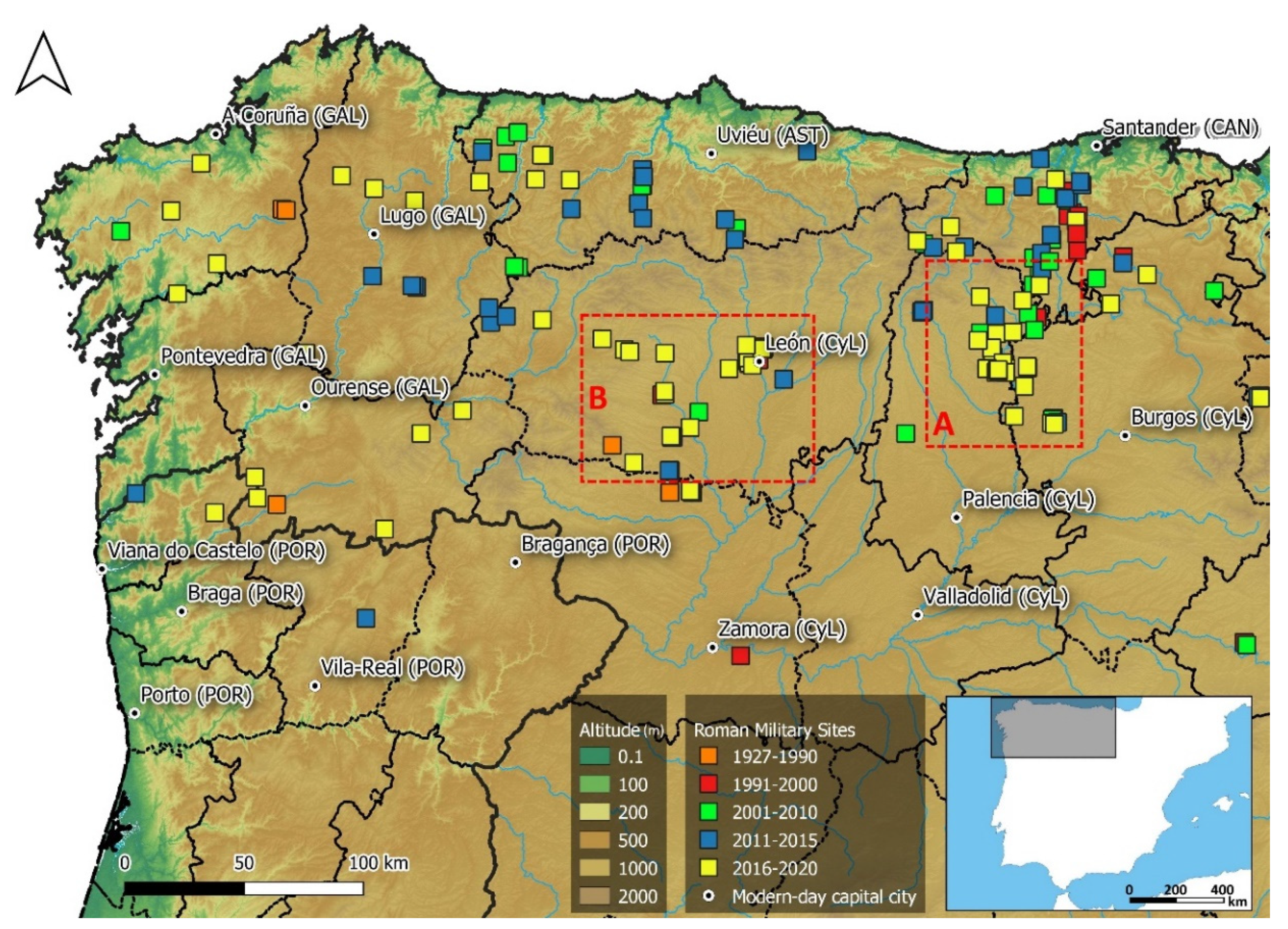
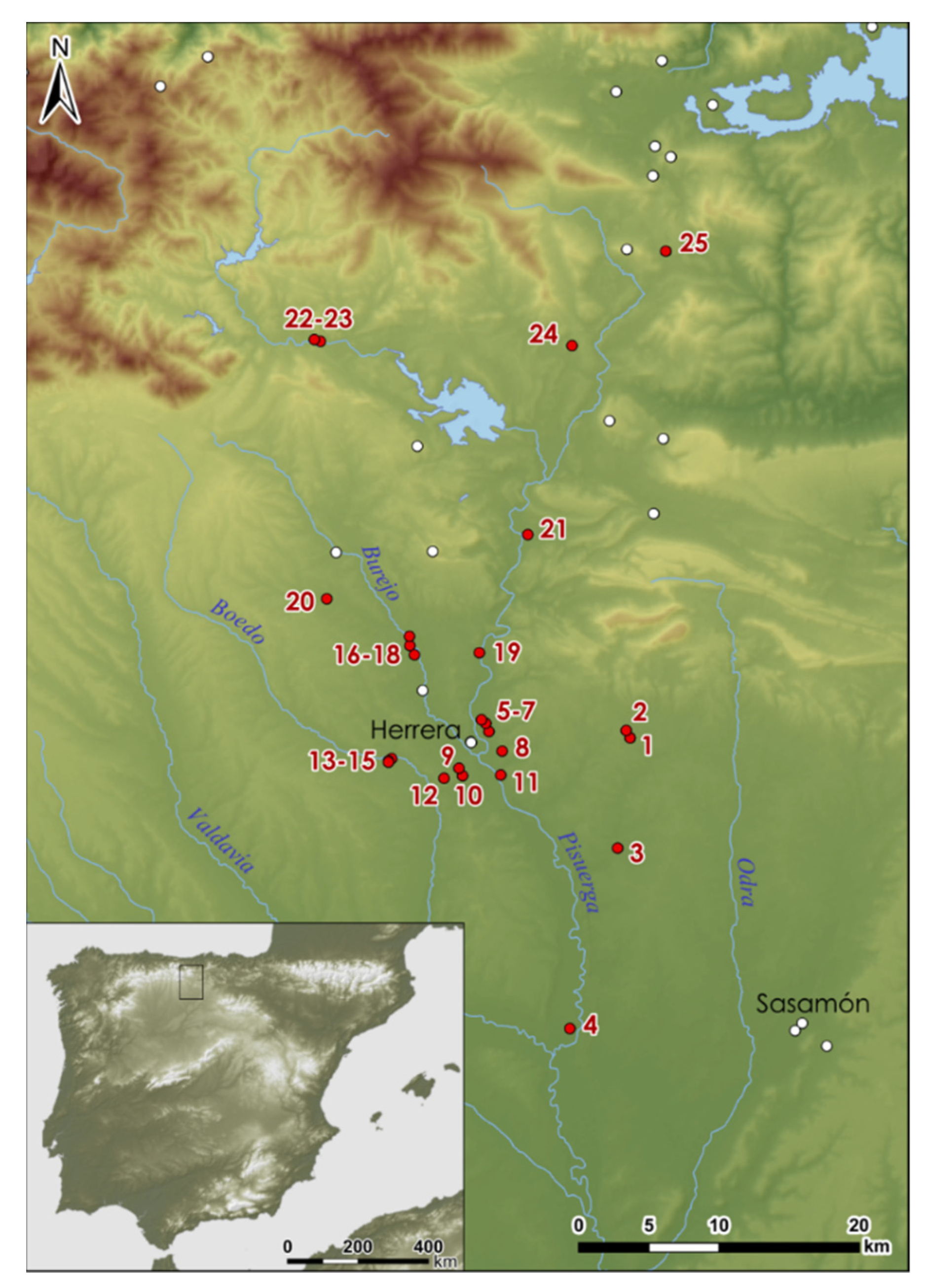
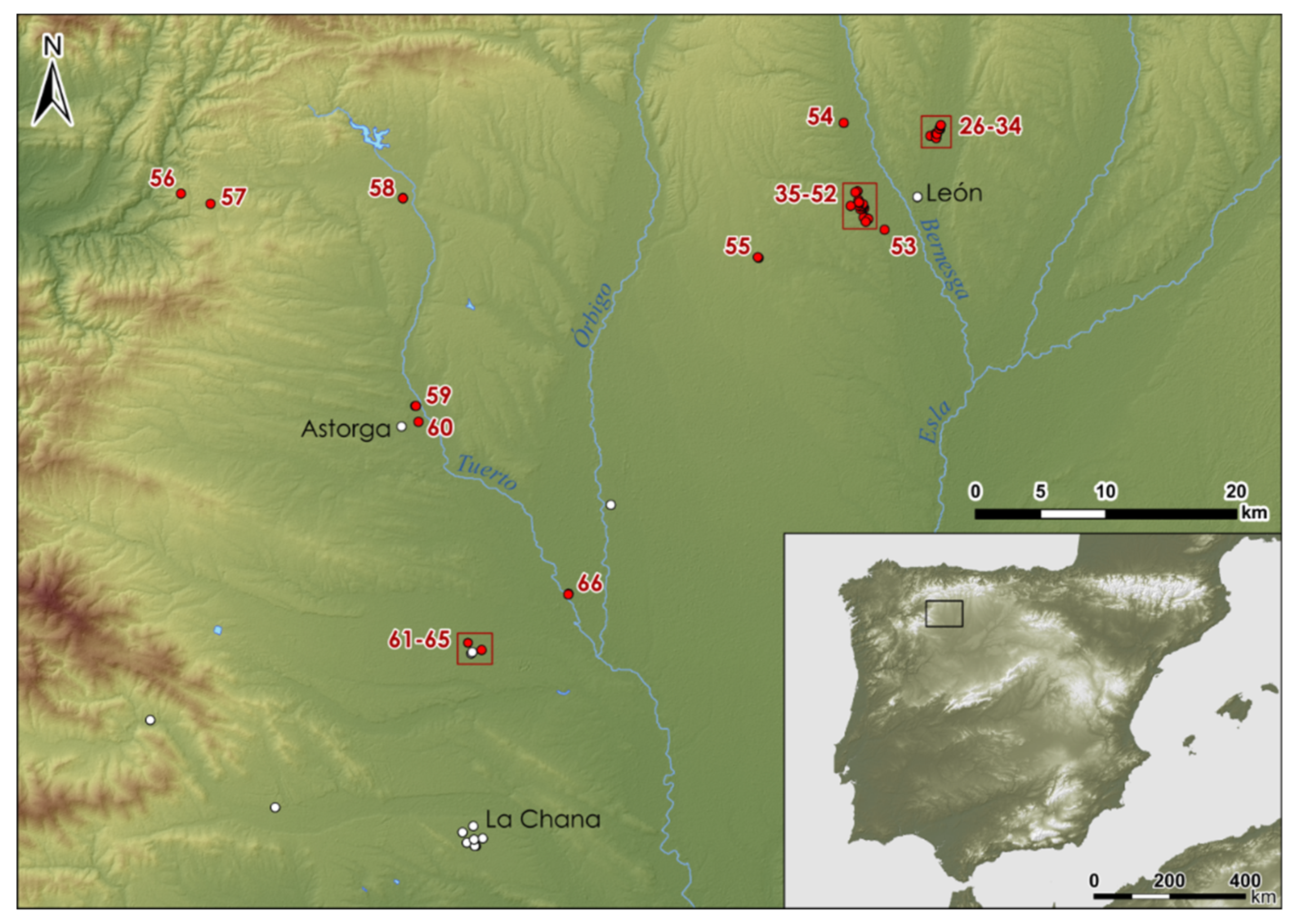
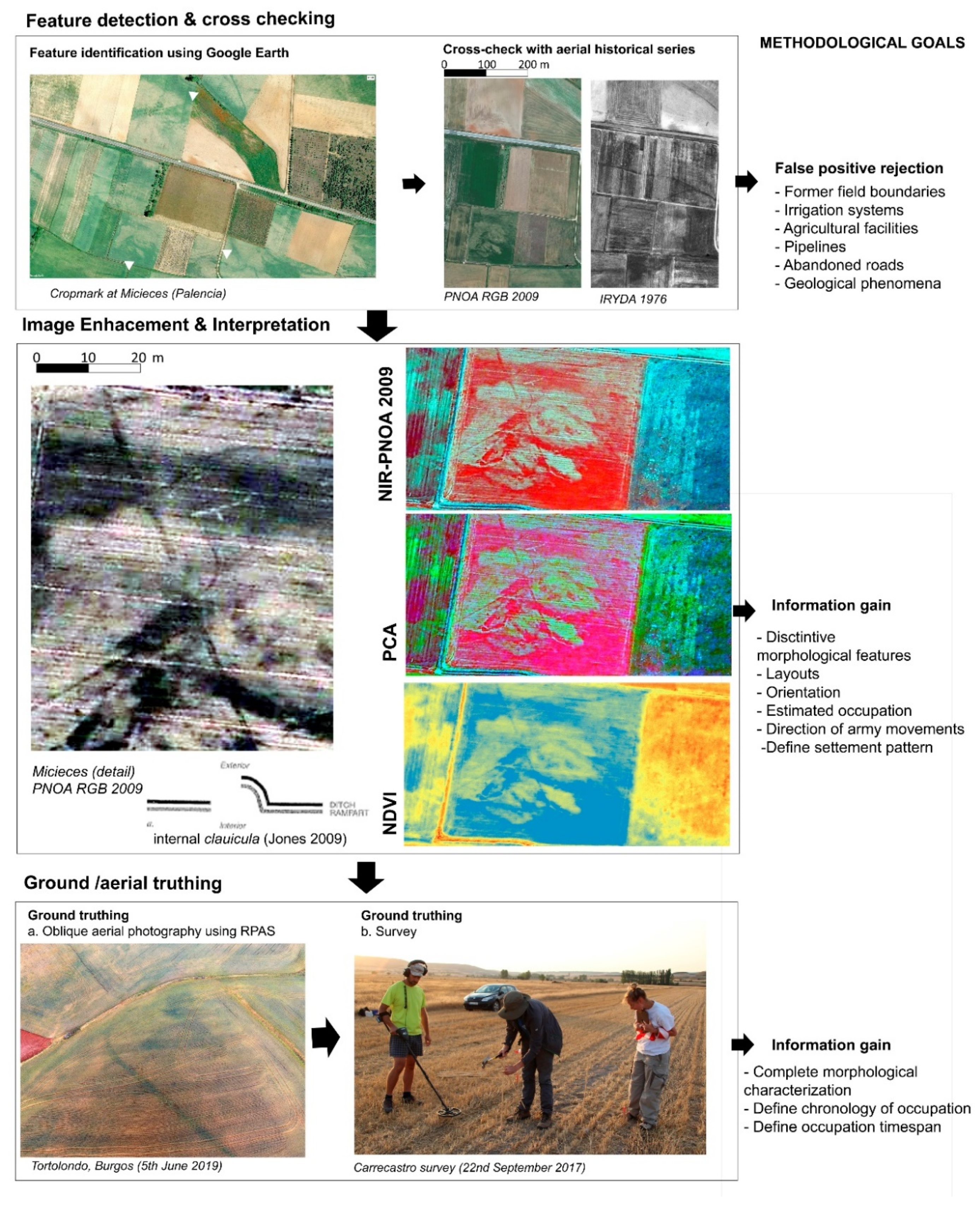
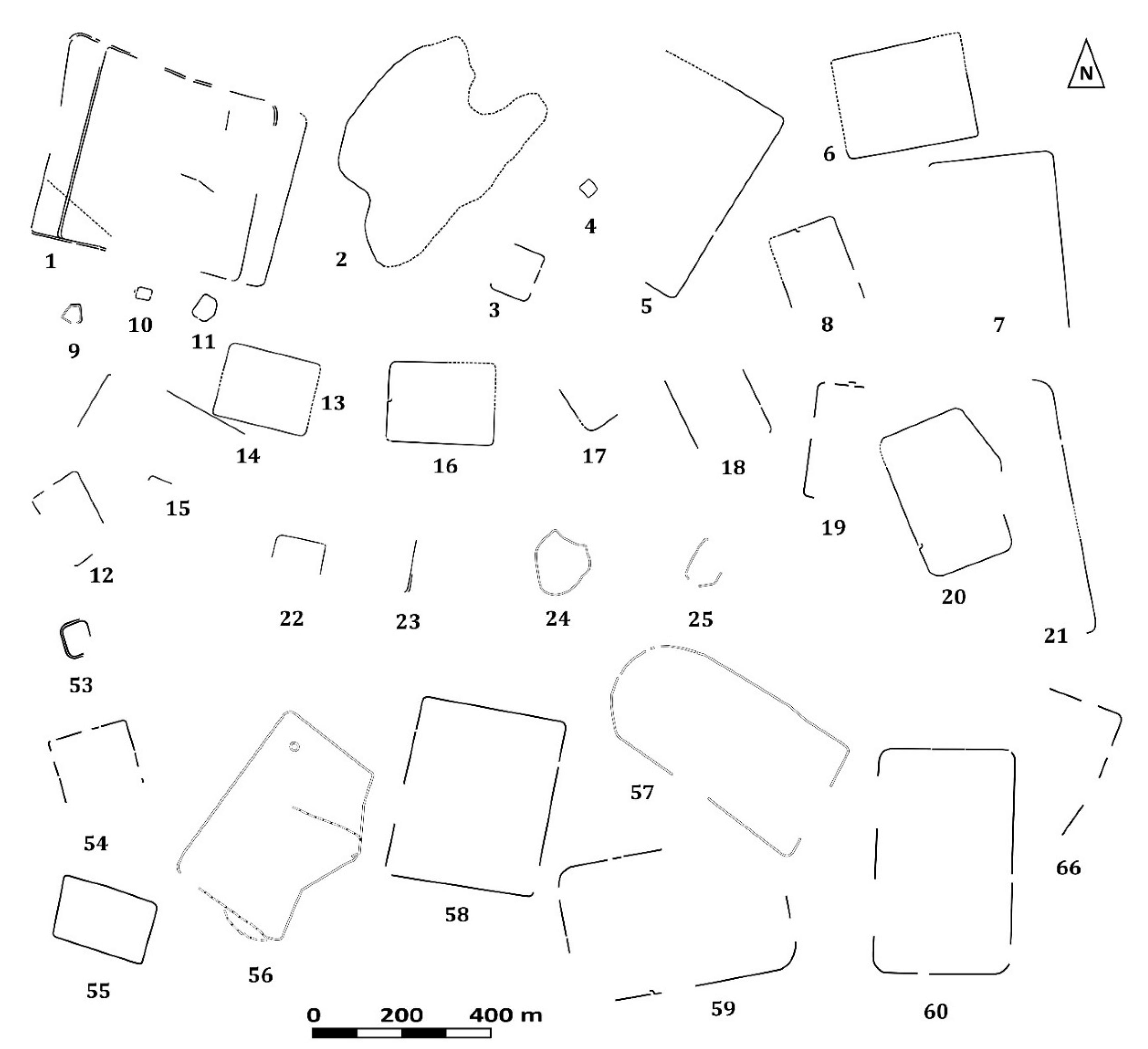
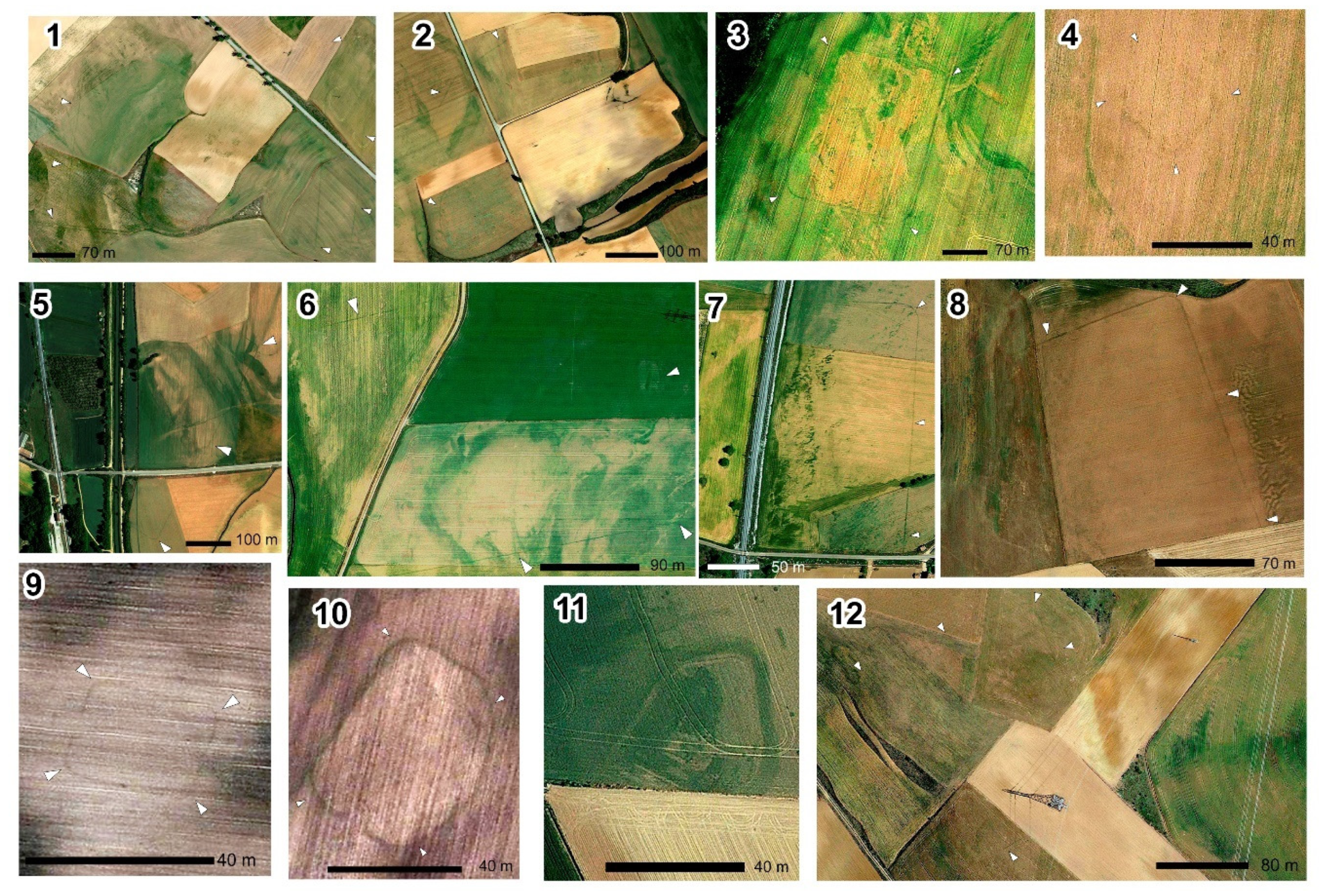
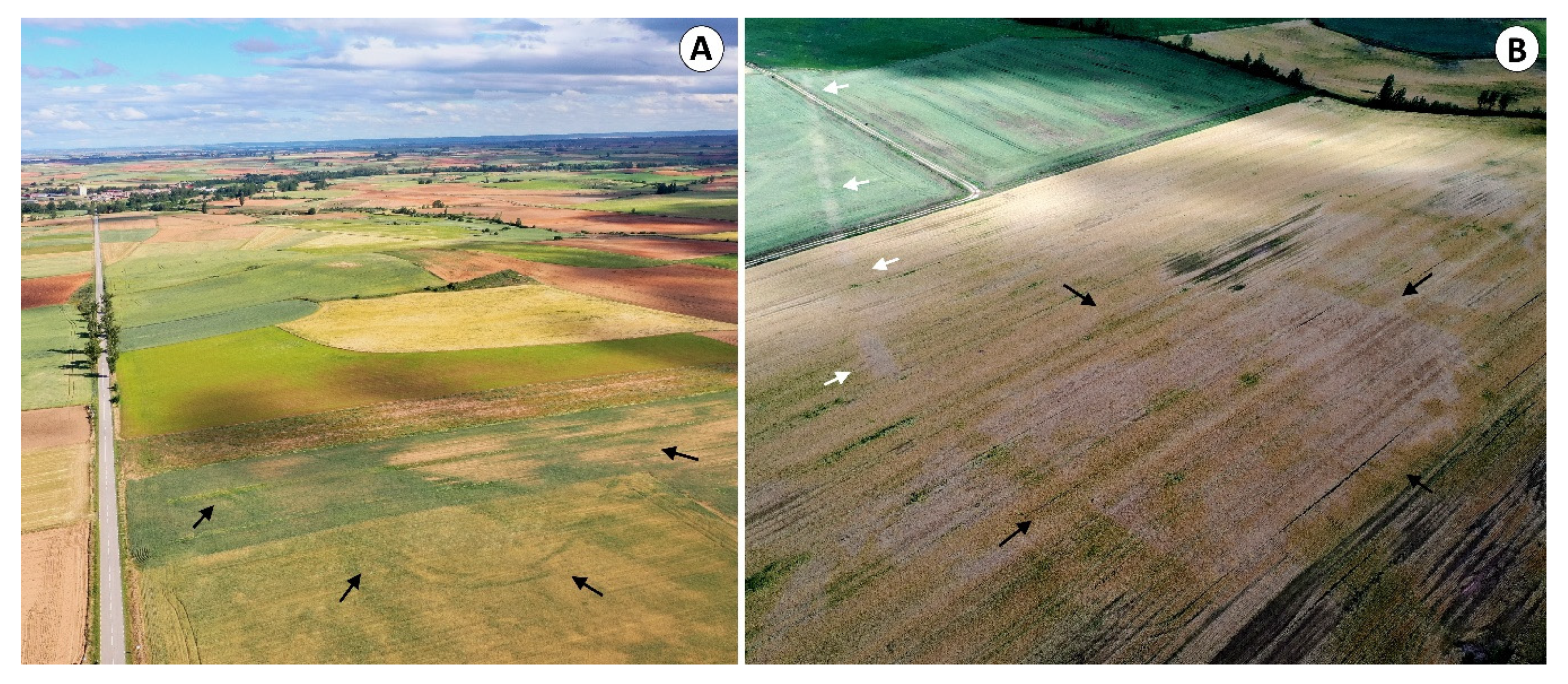
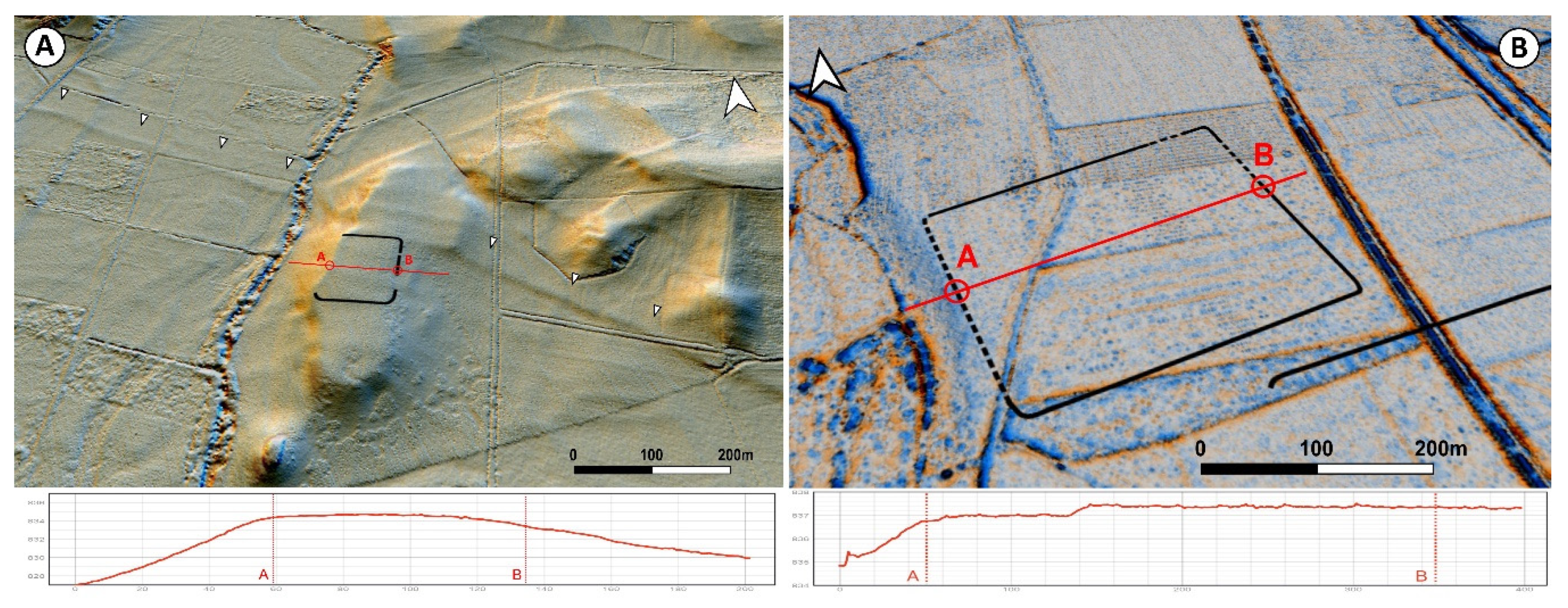
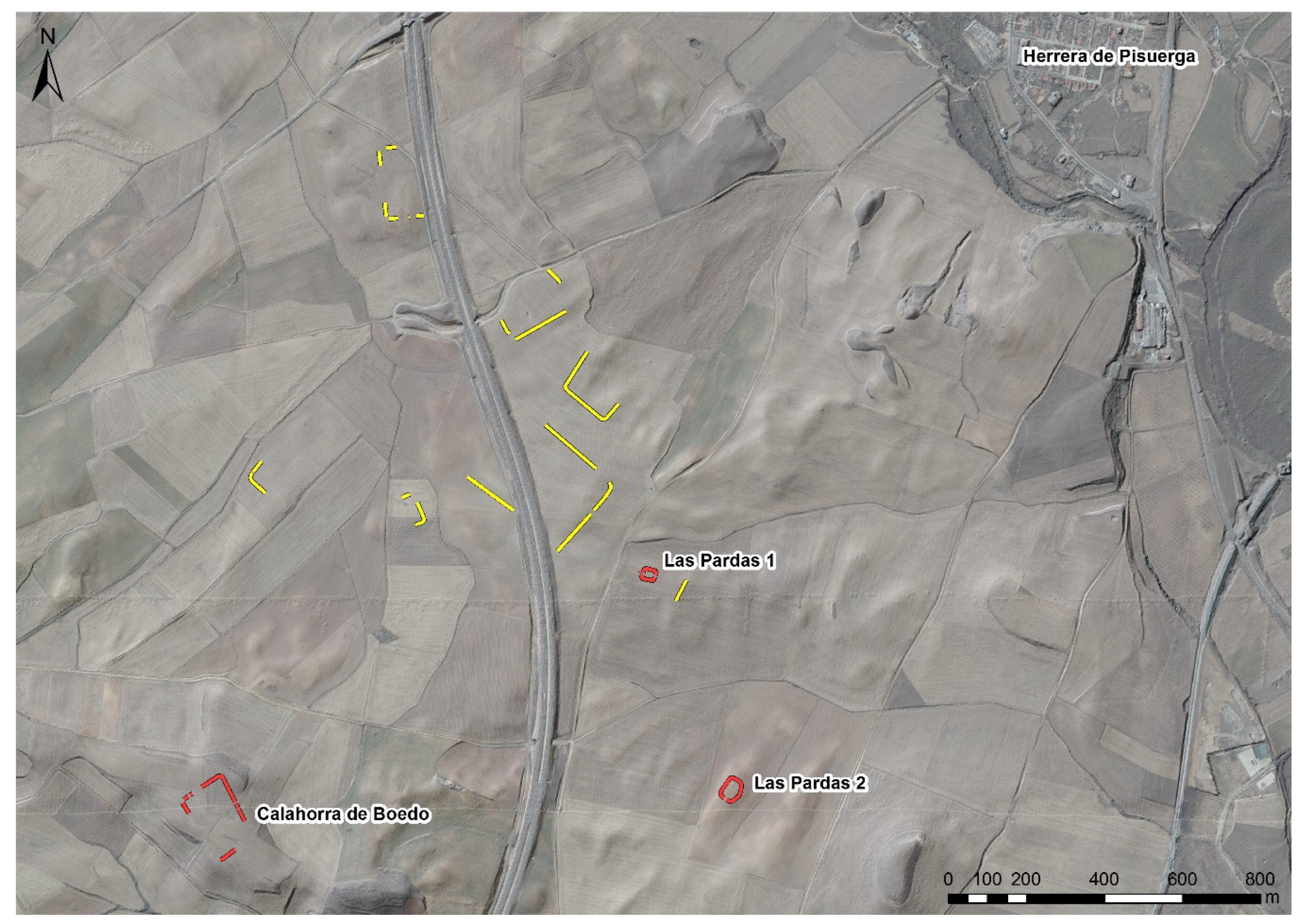
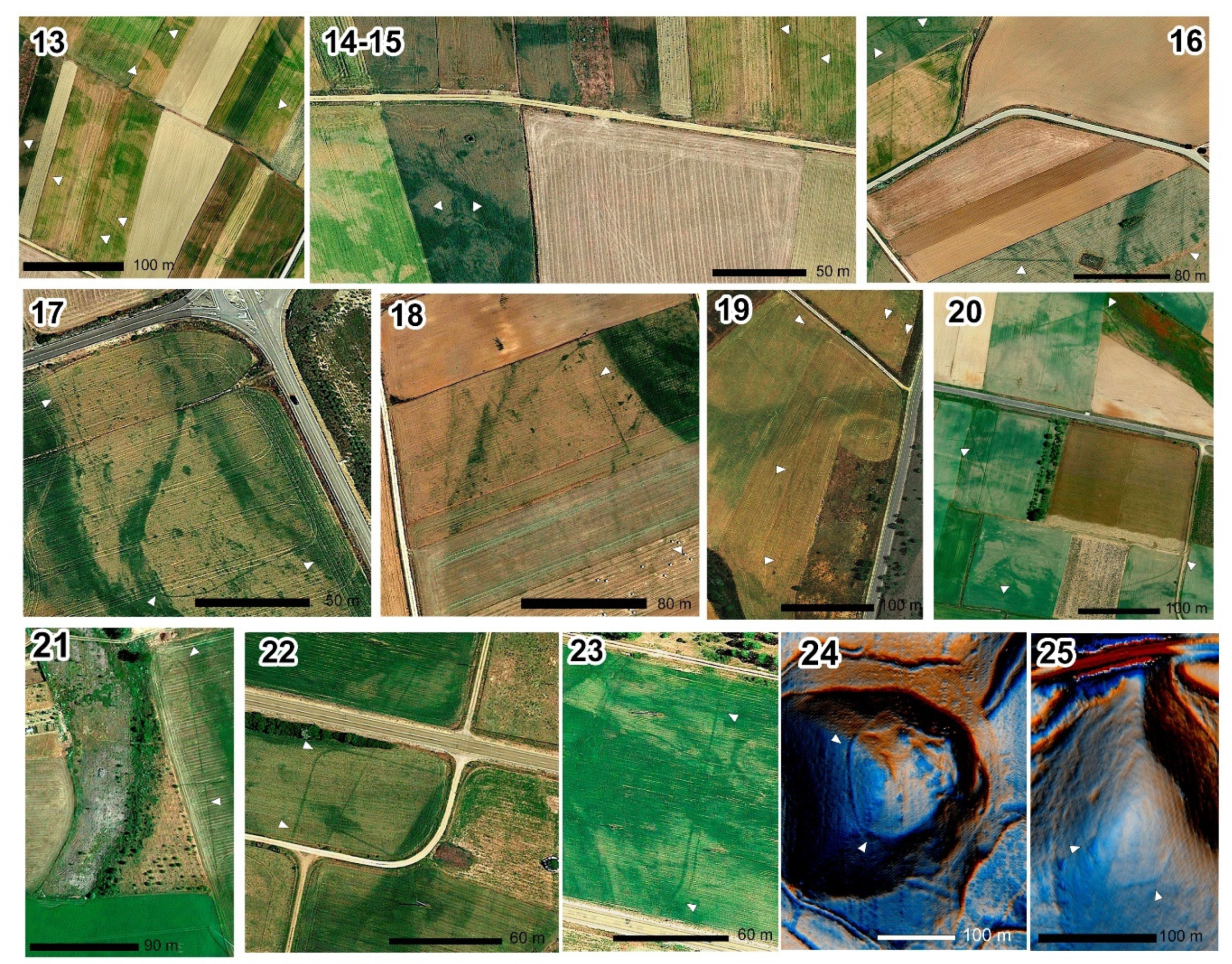
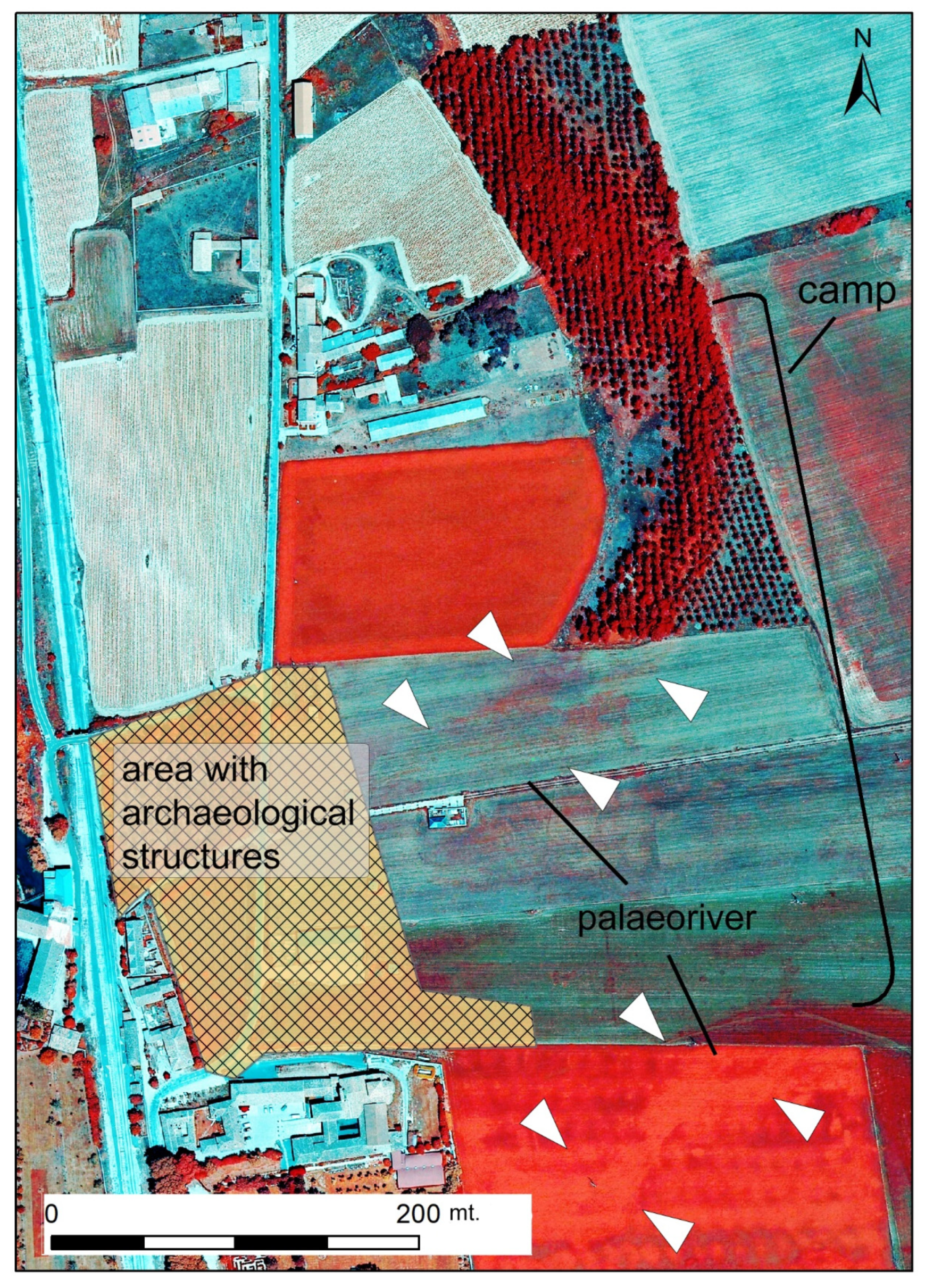
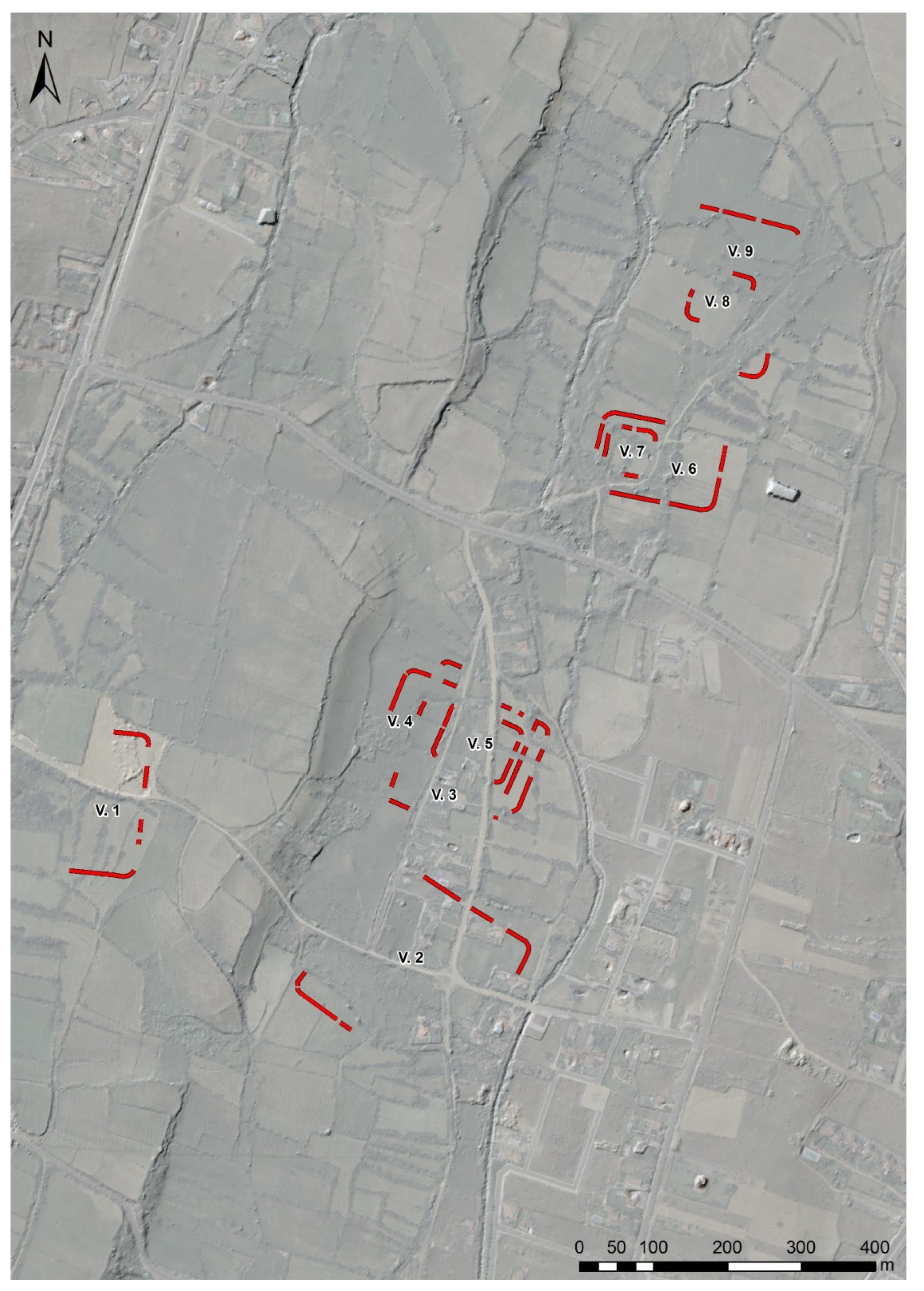
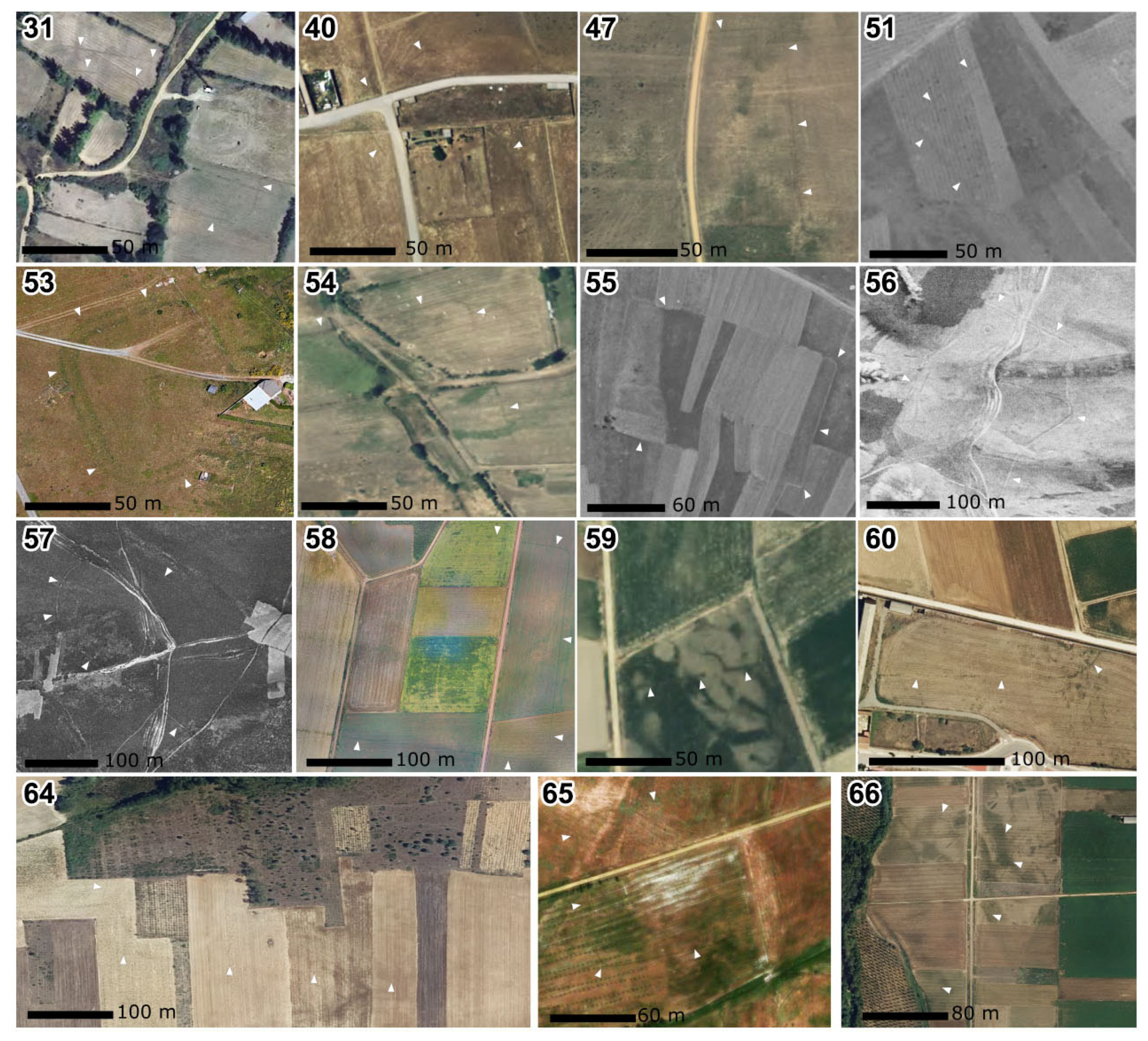
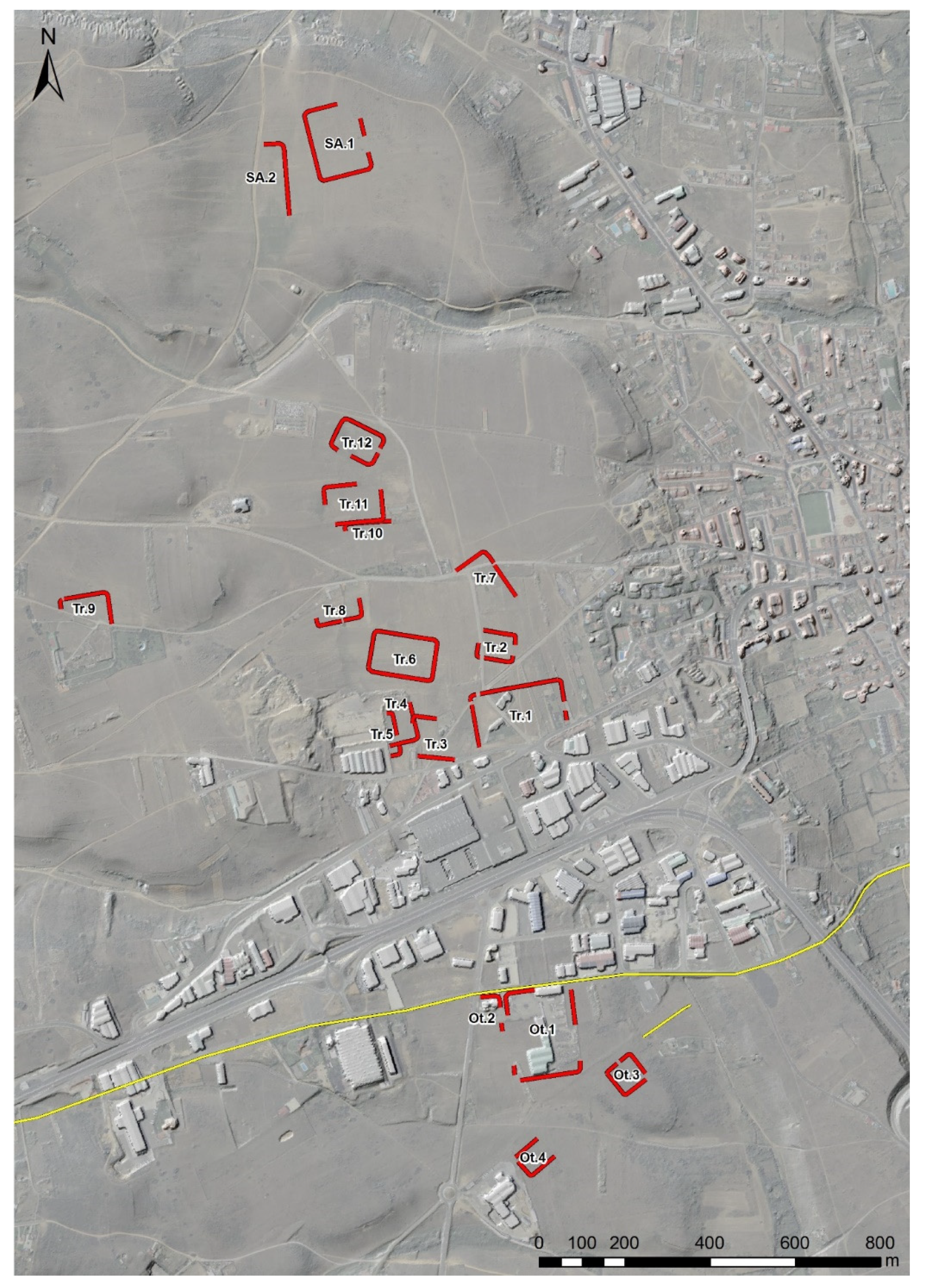
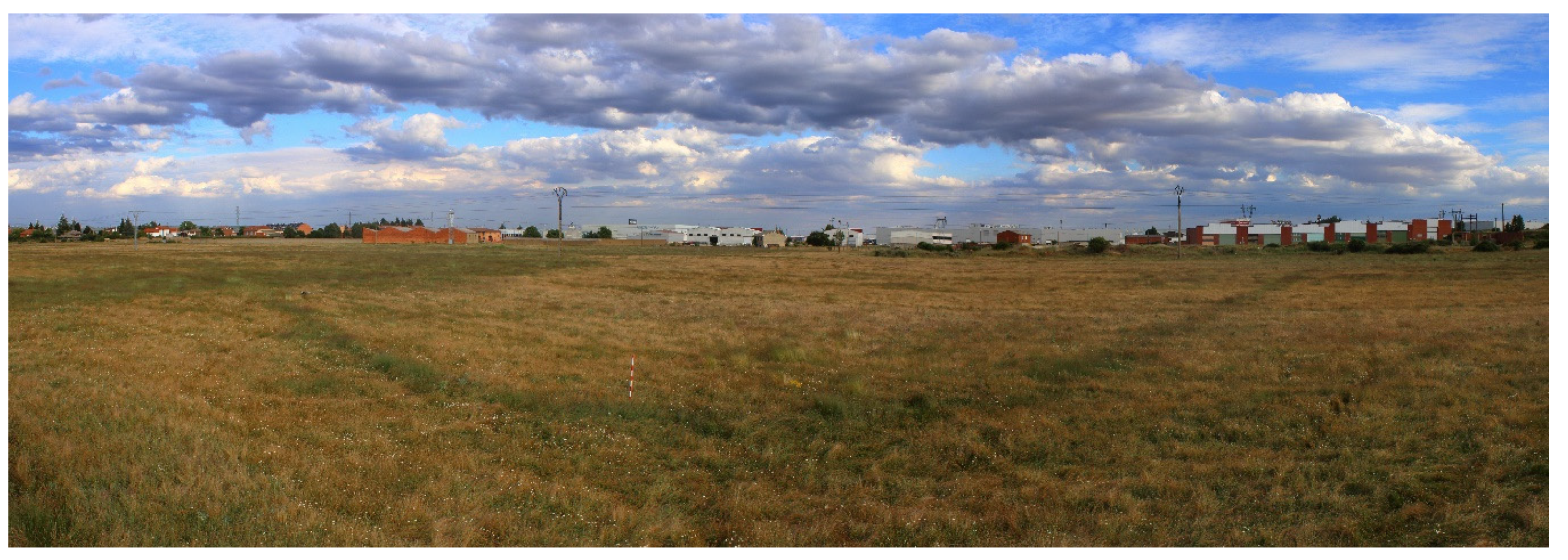
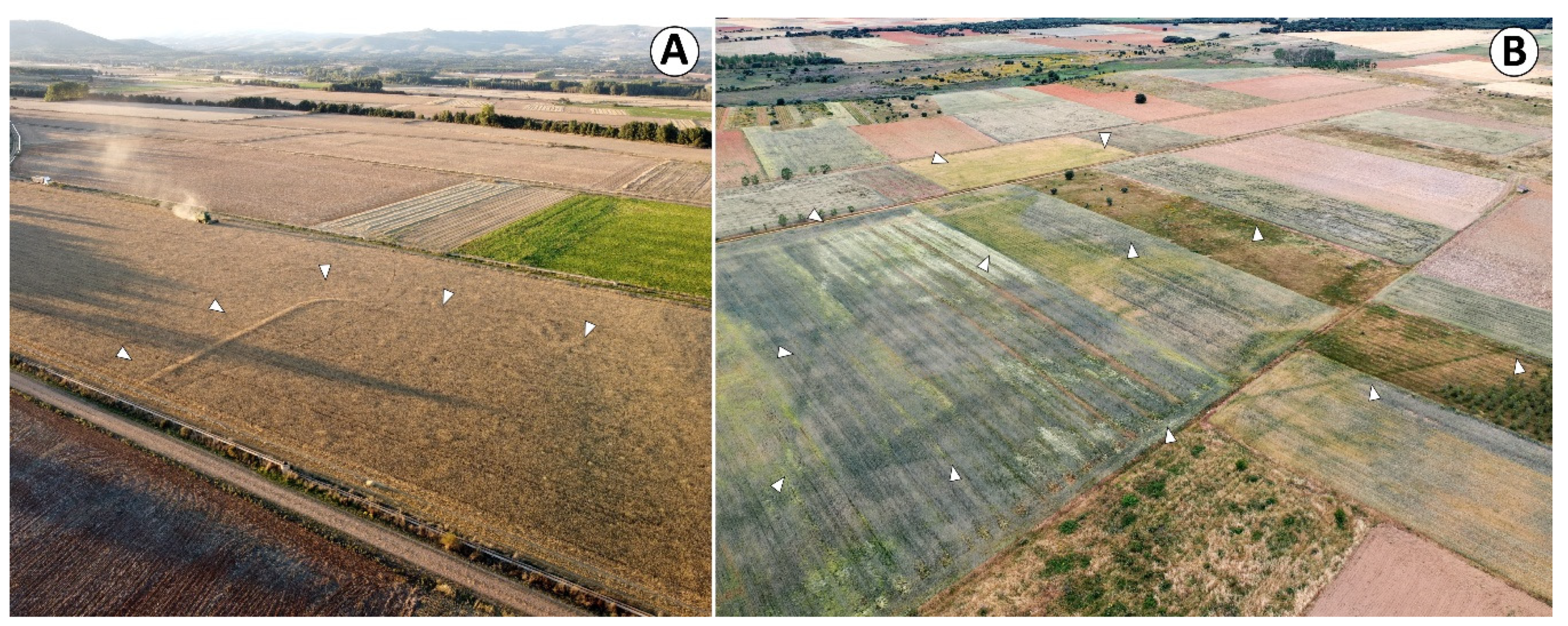
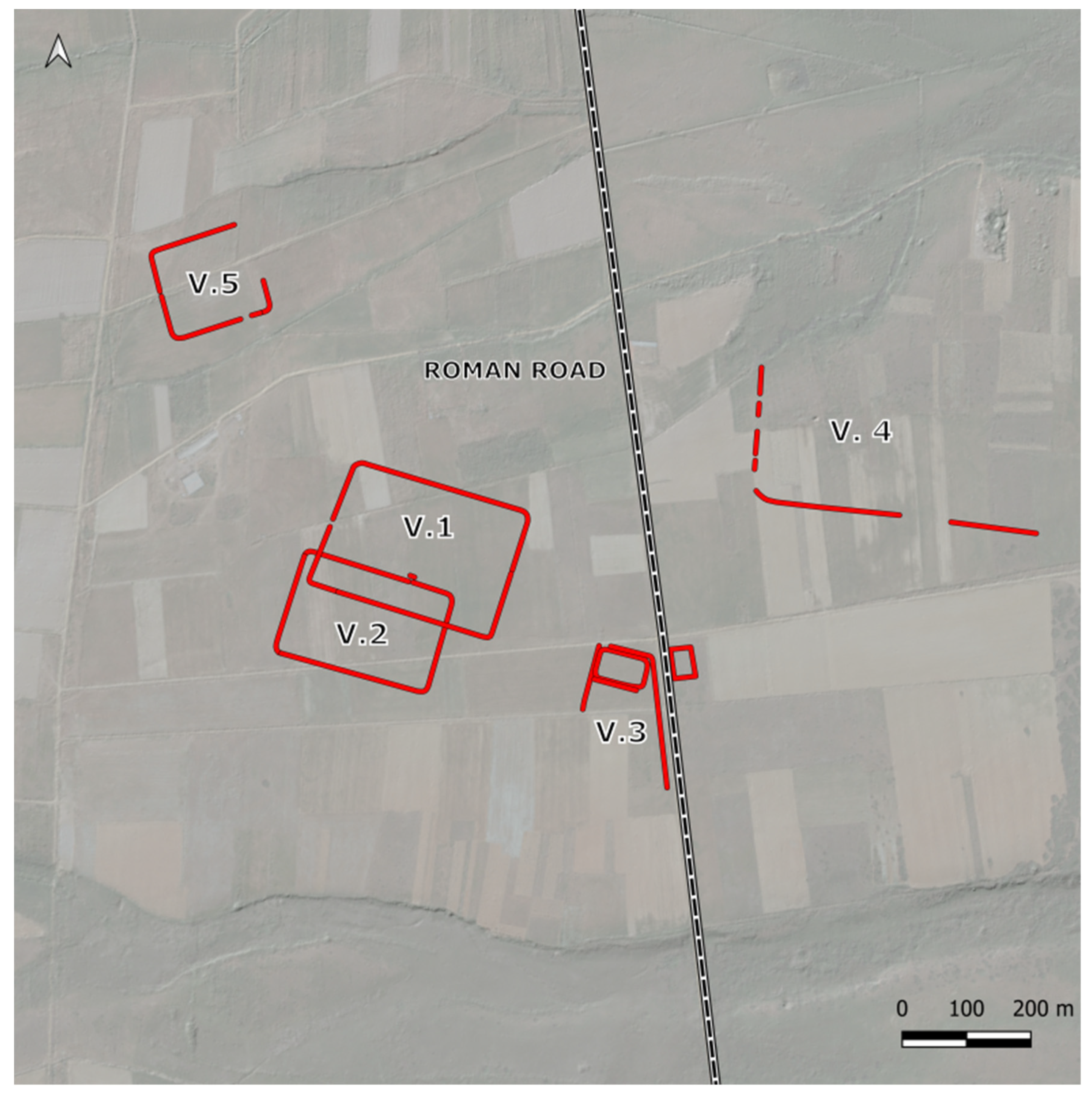
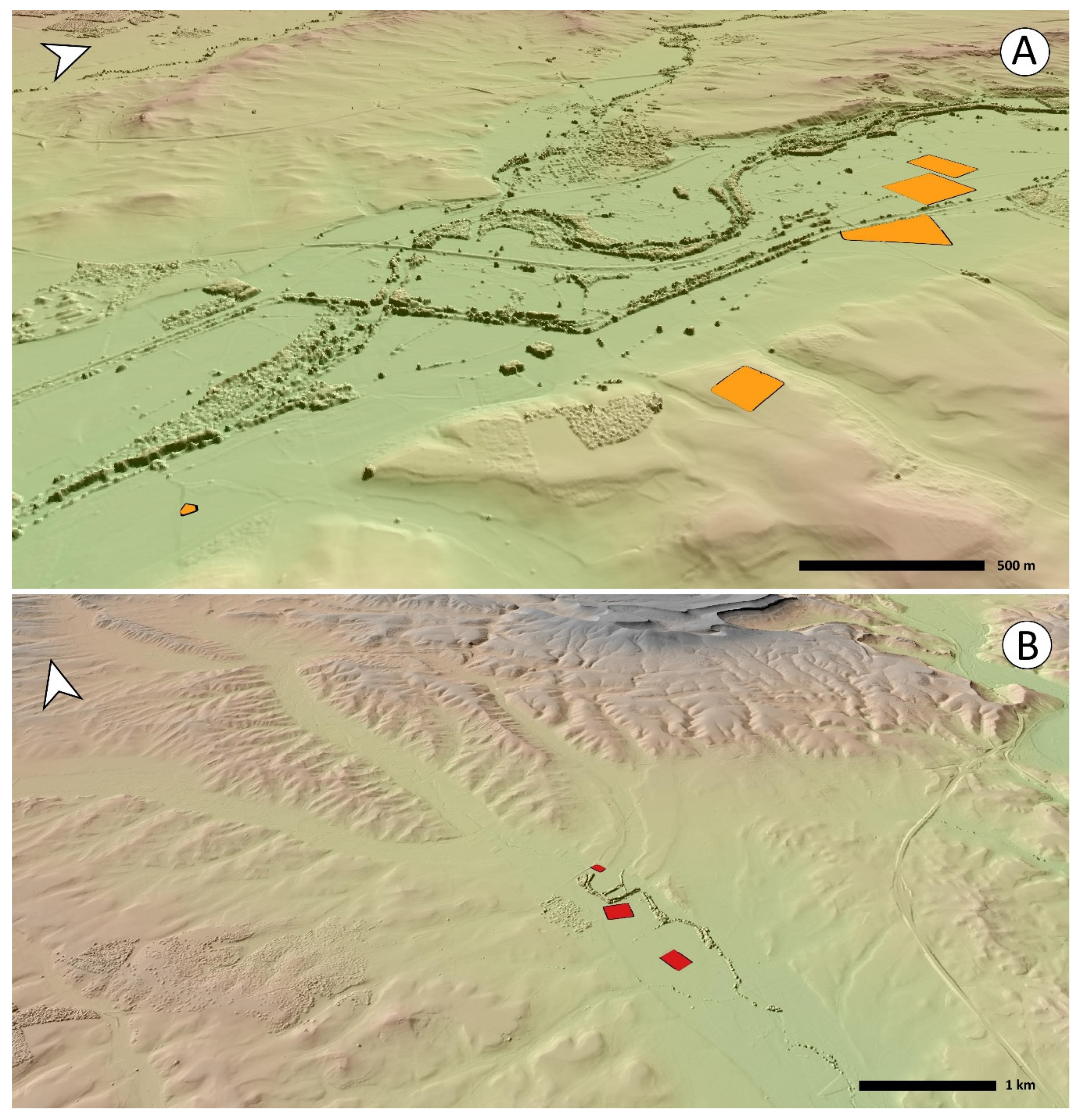
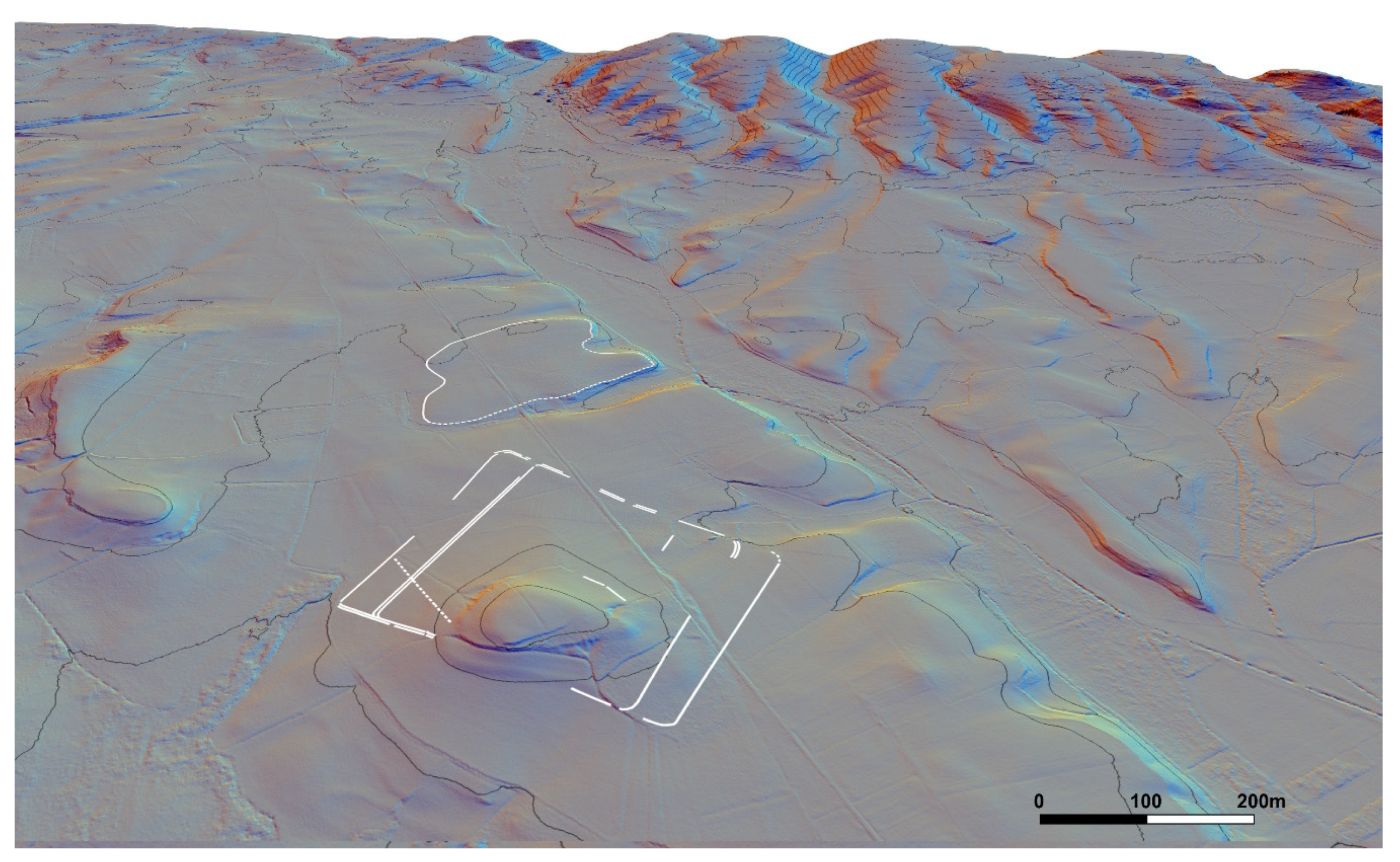
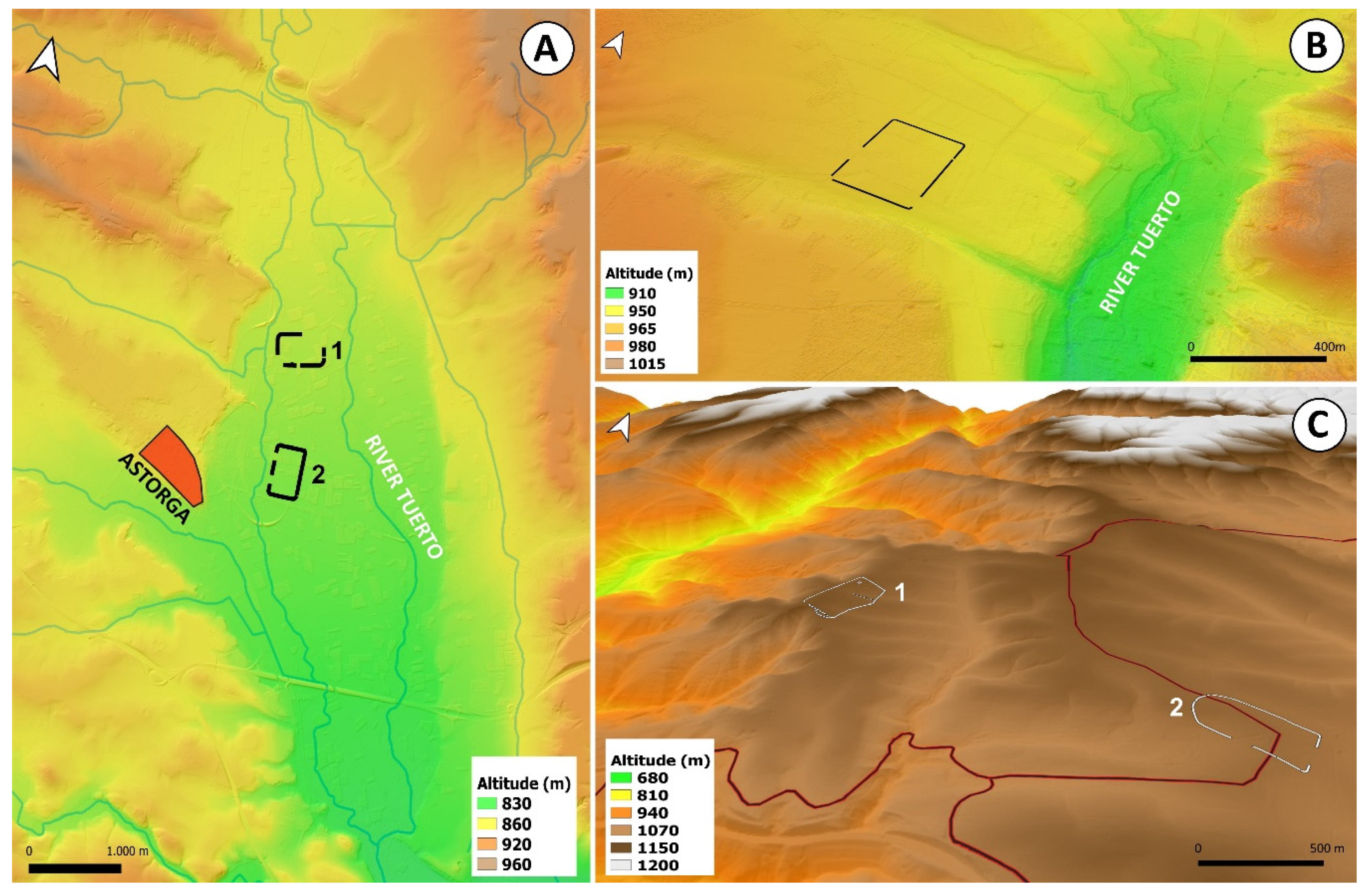
| Source | Source Type | Date | GSD 4 | Open Access | Effectiveness | Provider |
|---|---|---|---|---|---|---|
| Google Earth (2) | Satellital | 17 June 2019 | 42 cm | Yes | 1,2,3 | GeoEye (sat.) |
| Lidar 1st Coverage (2) | Airborne LiDAR | 2010–2011 | 0.5 pt/m2 | Yes | 1,3 | CNIG |
| PNOA RGB (2,3) | Airborne orthophoto | 2009 | 22 cm | Yes | 1,2,3 | CNIG |
| PNOA NIR (3) | Airborne orthophoto | 2009 | 22 cm | Yes | 1,3 | CNIG |
| PNOA RGB (2,3) | Airborne orthophoto | 2017 | 35 cm | Yes | 1,2,4,5 | CNIG |
| PNOA RGB (2,3) | Airborne orthophoto | 2014 | 45 cm | Yes | 2,3,6 | CNIG |
| PNOA RGB (2,3) | Airborne orthophoto | 2011 | 45 cm | Yes | 2,7 | CNIG |
| PNOA RGB (2,3) | Airborne orthophoto | 2007 | 45 cm | Yes | 2 | CNIG |
| PNOA RGB (2,3) | Airborne orthophoto | 2006 | 50 cm | Yes | 4,5 | CNIG |
| PNOA RGB (2,3) | Airborne orthophoto | 2008 | 25 cm | Yes | 4,5 | CNIG |
| PNOA RGB (2,3) | Airborne orthophoto | 2010 | 50 cm | Yes | 4 | CNIG |
| Google Earth (4) | Satellital | 13 September 2017 | <50 cm | Yes | 4 | CNIG |
| Google Earth (4) | Ortho | 08 September 2011 | <50 cm | Yes | 4 | Maxar Tech. |
| Interministerial (2) | Airborne orthophoto | 1973–1986 | 50 | Yes | 4,5 | CNIG |
| Bing (6) | Ortho | Not provided | <30 cm | Yes | 4,5 | Airbus (sat.) |
| Google Earth (4) | Ortho | 07 June 2016 | <50 cm | Yes | 4 | CNIG |
| SigPac (2,3) | Airborne orthophoto | 2002 | 50 cm | Yes | 4,5 | CNIG |
| Serie B (2) | Airborne orthophoto | 1956 | 125 cm | Yes | 4,5 | CNIG |
| Nacional (2) | Airborne orthophoto | 1984 | 65 cm | Yes | 4 | CNIG |
| Google Earth (4) | Satellital | 11 August 2007 | <50 cm | Yes | 4 | CNIG |
| Google Earth (4) | Satellital | 18 March 2020 | <50 cm | Yes | 4 | Maxar Tech. |
| Serie A (5) | Airborne orthophoto | 1945–1946 | 1–2 m | Yes | 5 | CNIG |
| PNOA RGB (2,3) | Airborne orthophoto | 2004 | 50 cm | Yes | 5 | CNIG |
| Google Earth (4) | Satellital | 12 June 2009 | <50 cm | Yes | 5 | Maxar Tech. |
| Google Earth (4) | Satellital | 29 May 2009 | <50 cm | Yes | 5 | Maxar Tech. |
| Google Earth (4) | Satellital | 13 September 2017 | <50 cm | Yes | 5 | Maxar Tech. |
| Google Earth (4) | Satellital | 19 September 2010 | <50 cm | Yes | 5 | Maxar Tech. |
| Google Earth (4) | Satellital | 23 August 2007 | <50 cm | Yes | 5 | Maxar Tech. |
| Google Earth (4) | Satellital | 1 June 2009 | <50 cm | Yes | 5 | Maxar Tech. |
| Google Earth (4) | Satellital | 16 June 2015 | <50 cm | Yes | 5 | Maxar Tech. |
| UAV (7) | Photogrammetric Flights | June 2020 | <5 cm | No | 4,5 | J. M. Costa-García |
| Nº | Name | Layout | Dimensions (m) | Size (ha) | Defensive Perimeter (m) | Slope (Mean in Degrees) | Defences | Ditches | Gates | Hypothetical Garrison |
|---|---|---|---|---|---|---|---|---|---|---|
| 1 | Tortolondro (int) | Irregular playing-card | 457 × 421 | 18.18 | 1641 | 4.55 | Cropmark | 2 | - | 8900–11,500 (min) |
| Tortolondro (ext) | Irregular playing-card | 570 × 470 | 23.87 | 1930 | 4.16 | Cropmark | 2 | - | 11,500–15,100 (min) | |
| 2 | Matimocha | Irregular | 505 × 354 | 13.30 (est) | 1555 | 1.93 | Cropmark | 1 | - | 6500–8500 |
| 3 | La Calzada | Playing-card | 113 × 93 | 0.94 | 273 | 2.09 | Cropmark | 1 | - | 450–600 |
| 4 | San Andrés | Square | 33 × 32 | 0.1 | 121 | 4.01 | Cropmark | 1 | - | 50–60 |
| 5 | Herrera 1 | Playing-card | 482 × 318 | 9.4 (min) | 860 (min) | 2.16 | Cropmark | 1 | - | 3100–6000 (min) |
| 6 | Herrera 2 | Playing-card | 405 × 284 | 11.13 (min) | 676 (min) | 1.74 | Cropmark | 1 | - | 5400–7000 (min) |
| 7 | Herrera 3 | Playing-card | 304 × 240 | 7.02 (est) | 1032 (est) | 1.27 | Cropmark | 1 | - | 3400–4500 |
| 8 | Herrera 4 | Playing-card | 206 × 160 | 3.2 (est) | 707 (est) | 2.93 | Cropmark | 1 | 1 (Int. clauicula) | 1500–2000 |
| 9 | Las Pardas 1 | Playing-card | 33 × 27 | 0.08 | 109 | 1.54 | Cropmark | 1 | 1 (Titulus) | 140–150 |
| 10 | Las Pardas 2 | Irregular playing-card | 57 × 46 | 0.22 | 174 | 4.59 | Cropmark | 1 | 1 | 100–140 |
| 11 | Valdemiranda | Pentagonal | 43 × 27 | 0.08 (min) | 72.3 (min) | 1.4 | Cropmark | 1 | - | 40–55 (min) |
| 12 | Calahorra de Boedo | Irregular playing-card | 185 × 123 | 2.6 (est) | 571 (est) | 2.7 | Cropmark | 1 | - | 1250–1650 |
| 13 | Páramo de Boedo 1 | Playing-card | 216 × 169 | 3.6 | 471 | 1.09 | Cropmark | 1 | - | 1700–2300 |
| 14 | Páramo de Boedo 2 | Playing-card | 340 × 176 | 5.2 (min) | 474 | 1.19 | Cropmark | 1 | - | 2500–3300 (min) |
| 15 | Páramo de Boedo 3 | Playing-card (?) | 52 × 12 | 0.06 (min) | 58 | 1.32 | Cropmark | 1 | - | - |
| 16 | La Vid de Ojeda 1 | Playing-card | 245 × 183 | 4.37 | 820 | 1.54 | Cropmark | 1 | 1 (Int. clauicula) | 2100–2800 |
| 17 | La Vid de Ojeda 2 | Playing-card (?) | 119 × 74 | 0.92 (min) | 189 (min) | 1.51 | Cropmark | 1 | - | 450–600 (min) |
| 18 | La Vid de Ojeda 3 | Playing-card | 200 × 171 | 3.43 (min) | 517 (min) | 1.45 | Cropmark | 1 | - | 1700–2200 (min) |
| 19 | La Charcona | Playing-card (?) | 258 × 109 | 2.54 (min) | 376 (min) | 1.96 | Cropmark | 1 | 1 (Titulus) | 1200–1600 (min) |
| 20 | Micieces | Irreg. Playing-card | 345 × 246 | 7.43 | 1069 | 1.73 | Cropmark | 1 | 1 (Int. clauicula) | 3500–4500 |
| 21 | La Capilla | Playing-card? | 416 × 33 | - | 433 (min) | 1.7 | Cropmark | 1 | - | - |
| 22 | Ligüérzana 1 | Playing-card? | 116 × 70 | 0.76 (min) | 223 (min) | 1.2 | Cropmark | 1 | - | 350–500 |
| 23 | Ligüérzana 2 | Unknown | 122 × 11 | - | 120 (min) | 1.59 | Cropmark | 2 | - | - |
| 24 | Nestar | Irregular | 150 × 126 | 1.23 | 417 | 7.62 | Earthwork | - | - | 600–800 |
| 25 | Matarrepudio | Unknown | 106 × 74 | 0.6 | 203 | 6.56 | Earthwork | - | - | 300–400 |
| Nº | Name | Layout | Dimensions (m) | Size (ha) | Defensive Perimeter (m) | Slope (Mean in Degrees) | Defences | Ditches | Gates | Hypothetical Garrison |
|---|---|---|---|---|---|---|---|---|---|---|
| 26 | Villaquilambre 1 | Playing-card | 194 × 89 (min) | 1.32 (min) | 318 (min) | 1.85 | Cropmark | 1 | - | 650–850 (min) |
| 27 | Villaquilambre 2 | Playing-card | 231 × 209 (est.) | 4.90 (est.) | 877 (est.) | 1.91 | Cropmark | 1 | - | 1700–2200 (min) |
| 28 | Villaquilambre 3 | Playing-card | 152 × 129 (min) | 1.22 (min) | 174 (min) | 1.59 | Cropmark | 1 | - | 600–800 (min) |
| 29 | Villaquilambre 4 | Playing-card | 210 × 127 (est) | 2 (est) | 649 (est) | 1.54 | Cropmark | 1 | - | 1000–1300 |
| 30 | Villaquilambre 5 | Playing-card | 102 × 80 | 0.77 | 342 | 1.7 | Cropmark | 1 | - | 400–500 |
| 31 | Villaquilambre 6 | Playing-card | 170 × 106 (est.) | 1.65 (est) | 531 (est) | 1.56 | Cropmark | 1 | - | 800–1050 |
| 32 | Villaquilambre 7 | Playing-card | 63 × 65 (est.) | 0.39 (est) | 245 (est) | 1.42 | Cropmark | 1 | - | 200–250 |
| 33 | Villaquilambre 8 | Playing-card | 80 × 77 (est.) | 0.32 (est.) | 285 (est.) | 0.92 | Cropmark | 1 | - | 150–200 (min) |
| 34 | Villaquilambre 9 | Playing-card | 203 × 149 (est.) | 2.98 (est.) | 677 (est.) | 1.17 | Cropmark | 1 | - | 850–1100 (min) |
| 35 | Trobajo 1 | Playing-card | 109 × 75 | 0.80 | 345 | 1.41 | Cropmark | 1 | - | 400–500 |
| 36 | Trobajo 2 | Playing-card | 133 × 90 | 1.18 (est.) | 429 (est.) | 0.57 | Cropmark | 1 | - | 600–750 (min) |
| 37 | Trobajo 3 | Playing-card | 110 × 15 (min) | 0.16 (min) | 122 (min) | 1.33 | Cropmark | 1 | - | 80–100 (min) |
| 38 | Trobajo 4 | Playing-card | 113 × 75 (min) | 0.83 (min) | 252 (min) | 0.92 | Cropmark | 1 | - | 700–950 |
| 39 | Trobajo 5 | Playing-card | 107 × 45 (min) | 0.46 (min) | 294 (min) | 1.12 | Cropmark | 1 | - | 650–850 |
| 40 | Trobajo 6 | Playing-card | 133 × 85 (min) | 1.03 (min) | 208 (min) | 0.76 | Cropmark | 1 | - | 500–650 (min) |
| 41 | Trobajo 7 | Playing-card | 151 × 96 | 1.44 | 478 | 0.91 | Cropmark | 1 | - | 700–900 |
| 42 | Trobajo 8 | Playing-card | 85 × 64 | 0.53 (est) | 288 (est) | 1.52 | Cropmark | 1 | - | 250–350 |
| 43 | Trobajo 9 | Playing-card | 213 × 128 (min) | 2.43 (min) | 429 (min) | 1.41 | Cropmark | 1 | - | 1300–1700 |
| 44 | Trobajo 10 | Playing-card | 105 × 92 (min) | 1.07 (min) | 158 (min) | 0.99 | Cropmark | 1 | - | 500–650 |
| 45 | Trobajo 11 | Playing-card | 91 × 70 (min) | 0.68 (min) | 154 (min) | 0.95 | Cropmark | 1 | - | 350–450 |
| 46 | Trobajo 12 | Playing-card | 100 × 26 (min) | 0.54 (min) | 130 (min) | 0.86 | Cropmark | 1 | - | 250–350 |
| 47 | San Andrés 1 | Playing-card | 173 × 139 (min) | 2.44 (min) | 296 (min) | 0.74 | Cropmark | 1 | - | 1200–1550 |
| 48 | San Andrés 2 | Playing-card | 166 × 124 | 2.06 | 563 | 1.41 | Cropmark | 1 | - | 1000–1300 |
| 49 | Oteruelo 1 | Playing-card | 206 × 154 | 3.17 (est) | 702 (est) | 1.63 | Cropmark | 1 | - | 1550–2000 |
| 50 | Oteruelo 2 | Playing-card | 137 × 102 | 1.38 (est) | 466 (est) | 1.35 | Cropmark | 1 | - | 650–900 |
| 51 | Oteruelo 3 | Playing-card | 71 × 70 | 0.50 (est) | 274 (est) | 0.8 | Cropmark | 1 | - | 250–300 |
| 52 | Oteruelo 4 | Playing-card | 75 × 57 | 0.43 (est) | 253 (est) | 1.53 | Cropmark | 1 | - | 200–250 |
| 53 | Oteruelo-Armunia | Playing-card | 84 × 63 | 0.45 (int) 0.54 (ext) | 179 (min) (int.) 145 (min) (ext) | 2.77 | Cropmark | 2 | - | 200–250 |
| 54 | Sariegos | Playing-card | 179 × 144 (min) | 2.56 (min) | 461 (min) | 2.12 | Cropmark | 1 | - | 1250–1650 |
| 55 | San Miguel del Camino | Playing-card | 215 × 145 | 3.07 | 697 | 0.81 | Cropmark | 1 | - | 1500–1950 |
| 56 | La Silva 1 | Irreg. Playing-Card | 441 × 320 (est) | 12.37 | 1415 (est) | 5.02 | Earthwork (razed) | - | 1 (Corridor) | 6000–7850 |
| 57 | La Silva 2 | Irreg. Playing-Card | 536 × 275 (est) | 13.74 | 1495 (est) | 3.43 | Earthwork (razed) | - | 1? | 6700–8700 |
| 58 | Sueros | Playing-card | 406 × 334 | 13.49 | 1447 | 0.58 | Cropmark | 1 | - | 6600–8600 |
| 59 | La Veiga | Playing-card | 505 × 316 | 15.73 (est) | 1542 (est) | 1.68 | Cropmark | 1 | 1 (int. clauicula) | 7650–10,000 |
| 60 | San Justo | Playing-card | 507 × 311 | 15.59 | 1574 | 1.40 | Cropmark | 1 | - | 7600–9900 |
| 61 | Villamontán de la Valduerna 1 | Playing-card | 287 × 205 | 5.90 | 969 | 0.66 | Cropmark | 1 | 2 | 2900–3750 |
| 62 | Villamontán de la Valduerna 2 | Playing-card | 243 × 164 | 3.92 | 790 | 0.61 | Cropmark | 1 | 1 (Titulus) | 1900–2500 |
| 63 | Villamontán de la Valduerna 3 | Playing-card | 77 × 46 | 0.34 | 229 | 0.46 | Cropmark | 1 | - | 150–200 |
| 64 | Villamontán de la Valduerna 4 | Playing-card (?) | 408 × 206 (min) | 9.4 (min) | 638 (min) | 0.74 | Cropmark | 1 | - | 4600–6000 |
| 65 | Villamontán de la Valduerna 5 | Playing-card | 145 × 142 | 2.25 (est) | 577 (est) | 0.95 | Cropmark | 1 | - | 1100–1400 |
| 66 | Huerga de Garaballes | Irr. Playing-Card | 299 × 185 | 4.66 (est) | 489 (est) | 2.18 | Cropmark | 1 | - | 2250–2950 |
Publisher’s Note: MDPI stays neutral with regard to jurisdictional claims in published maps and institutional affiliations. |
© 2020 by the authors. Licensee MDPI, Basel, Switzerland. This article is an open access article distributed under the terms and conditions of the Creative Commons Attribution (CC BY) license (http://creativecommons.org/licenses/by/4.0/).
Share and Cite
Menéndez Blanco, A.; García Sánchez, J.; Costa-García, J.M.; Fonte, J.; González-Álvarez, D.; Vicente García, V. Following the Roman Army between the Southern Foothills of the Cantabrian Mountains and the Northern Plains of Castile and León (North of Spain): Archaeological Applications of Remote Sensing and Geospatial Tools. Geosciences 2020, 10, 485. https://doi.org/10.3390/geosciences10120485
Menéndez Blanco A, García Sánchez J, Costa-García JM, Fonte J, González-Álvarez D, Vicente García V. Following the Roman Army between the Southern Foothills of the Cantabrian Mountains and the Northern Plains of Castile and León (North of Spain): Archaeological Applications of Remote Sensing and Geospatial Tools. Geosciences. 2020; 10(12):485. https://doi.org/10.3390/geosciences10120485
Chicago/Turabian StyleMenéndez Blanco, Andrés, Jesús García Sánchez, José Manuel Costa-García, João Fonte, David González-Álvarez, and Víctor Vicente García. 2020. "Following the Roman Army between the Southern Foothills of the Cantabrian Mountains and the Northern Plains of Castile and León (North of Spain): Archaeological Applications of Remote Sensing and Geospatial Tools" Geosciences 10, no. 12: 485. https://doi.org/10.3390/geosciences10120485
APA StyleMenéndez Blanco, A., García Sánchez, J., Costa-García, J. M., Fonte, J., González-Álvarez, D., & Vicente García, V. (2020). Following the Roman Army between the Southern Foothills of the Cantabrian Mountains and the Northern Plains of Castile and León (North of Spain): Archaeological Applications of Remote Sensing and Geospatial Tools. Geosciences, 10(12), 485. https://doi.org/10.3390/geosciences10120485









